Looking for a tool to help you create social content, schedule posts across all your channels, or analyze your social metrics?
In this article, we’ve gathered the best social media tools you can use in 2024.
But first, some quick background.
What Are Social Media Tools?
Social media tools are software solutions that help businesses simplify social media marketing and management. These types of tools can help you:
- Schedule and publish content across multiple social media platforms
- Reply to messages and comments received through different social media channels using a unified social inbox
- Monitor social media for mentions of your brand or your competitors
- Analyze the results of your social media marketing efforts and create reports you can download and share with stakeholders
With that in mind, let’s discuss the social media tools you should consider.
1. Semrush Social
Semrush Social is a suite of four tools designed to help companies streamline their social media management. It includes the Social Poster, Social Tracker, Social Analytics, and Social Inbox tools.
The Social Poster helps you draft, schedule, and publish posts across Facebook, Instagram, Twitter, LinkedIn, Pinterest, and Google Business Profile.
You can create for multiple channels at once or focus on one at a time (shown below). And plan out all of your social content in an easy-to-navigate calendar.
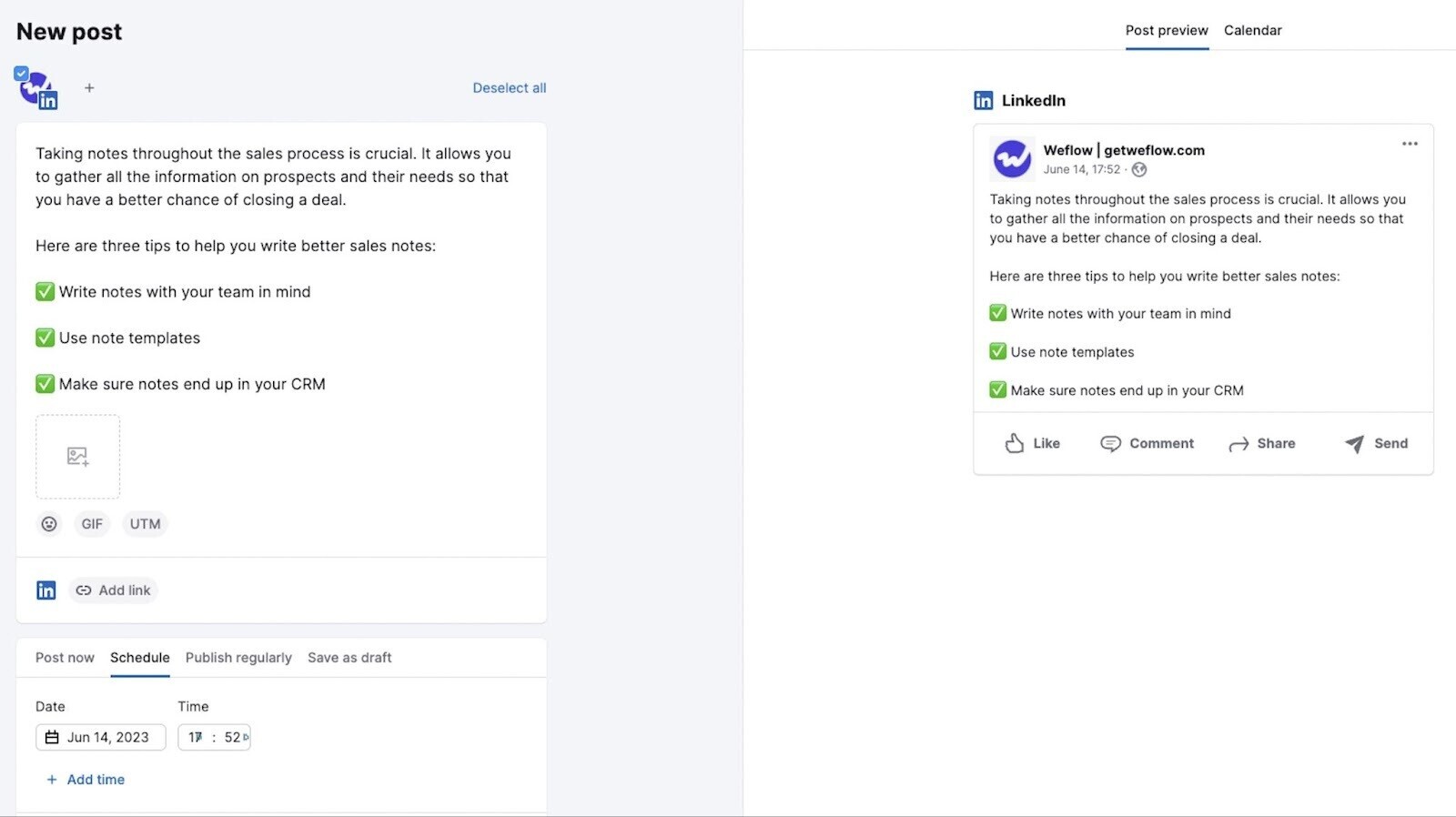
It includes a number of handy features that can save time, including a built-in image editor, a link shortener, and a UTM builder. You can also add your favorite news feeds and share that content with one click.
If you’re looking to get a better understanding of how your social media pages and posts are performing, you can use the Social Analytics tool. To monitor and track engagement, follower growth, reactions, and more.
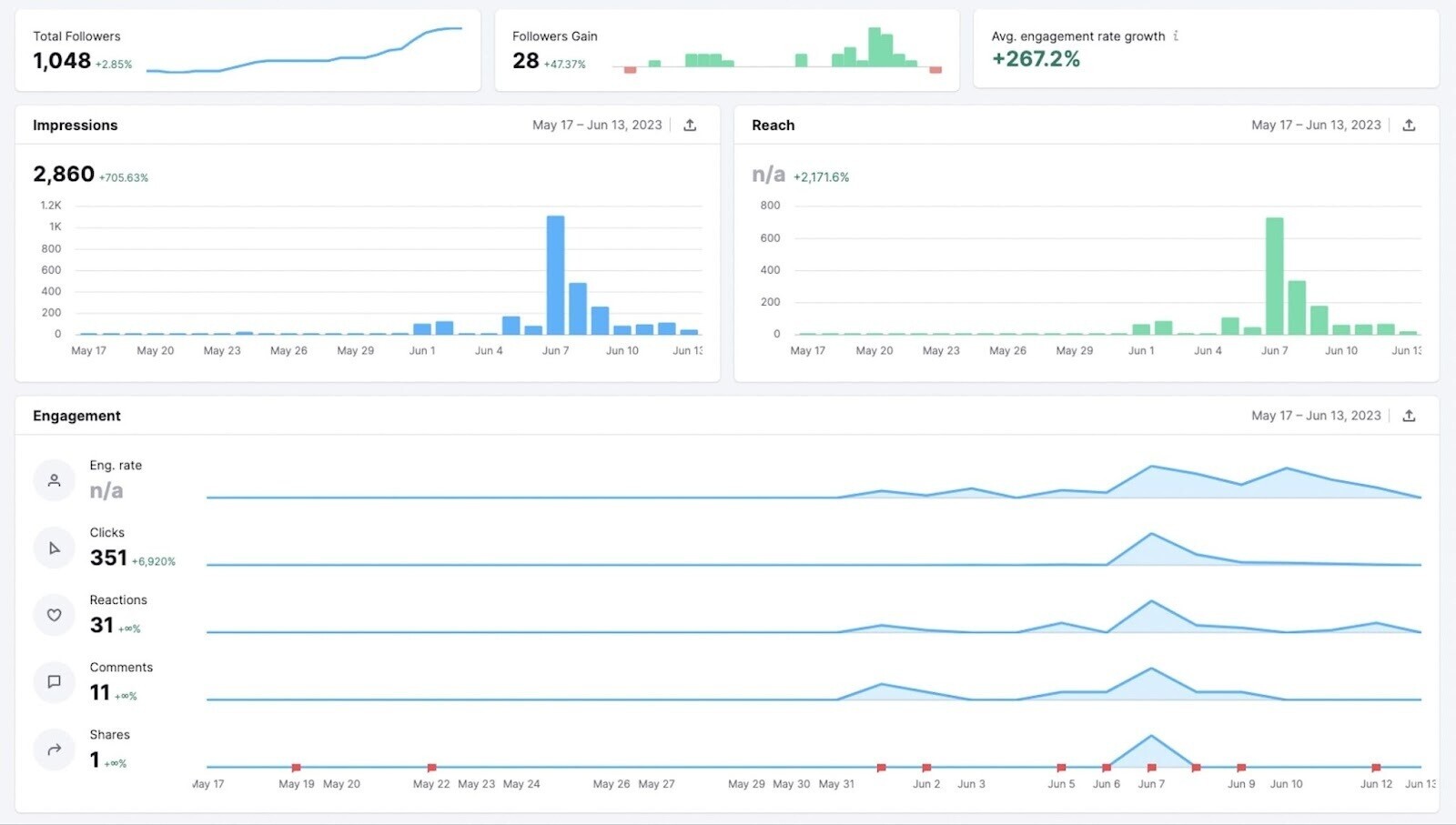
Use the Social Tracker tool to see your competitors’ social media activity. And learn what they’re doing to generate results, so you can adapt your strategy accordingly.
Finally, you can use Social Inbox to review and reply to comments and messages received across Facebook, Instagram, and LinkedIn.
What We Like
Semrush Social is a holistic solution that has everything you need to manage and grow your social media presence in one place. And setting it up is simple.
Price
This software is cost effective, at $19.79 per month.

2. Influencer Analytics
Influencer Analytics is a tool that helps you discover social media influencers and manage influencer marketing campaigns.
The tool’s database contains more than 29 million influencers across YouTube, Instagram, TikTok, and Twitch. You can search through the database by using keywords and hashtags. Or over 50 different filters.

Once you’ve found the right influencer, you can use Influencer Analytics to plan and manage the entire campaign from start to finish. And track performance in real time.
You can also use Influencer Analytics to analyze your competitors’ influencer marketing efforts. To learn which influencers they work with, how much they spend on influencer marketing, and more.

What We Like
Influencer Analytics’ algorithm analyzes each influencer’s profile to predict what kind of results you might expect from working with them.
It also detects fraudulent activity and accounts with fake or inflated follower counts. To ensure you only partner with influencers that have an engaged, high-quality audience.
Price
The Influencer Analytics app costs $169/month in the Semrush App Center. In-app purchases are also available:
- Competitor analysis ($129/month)
- Campaign management ($69/month)
- 25 tokens ($50/month)
- 40 tokens ($70/month)
- 100 tokens ($185/month)
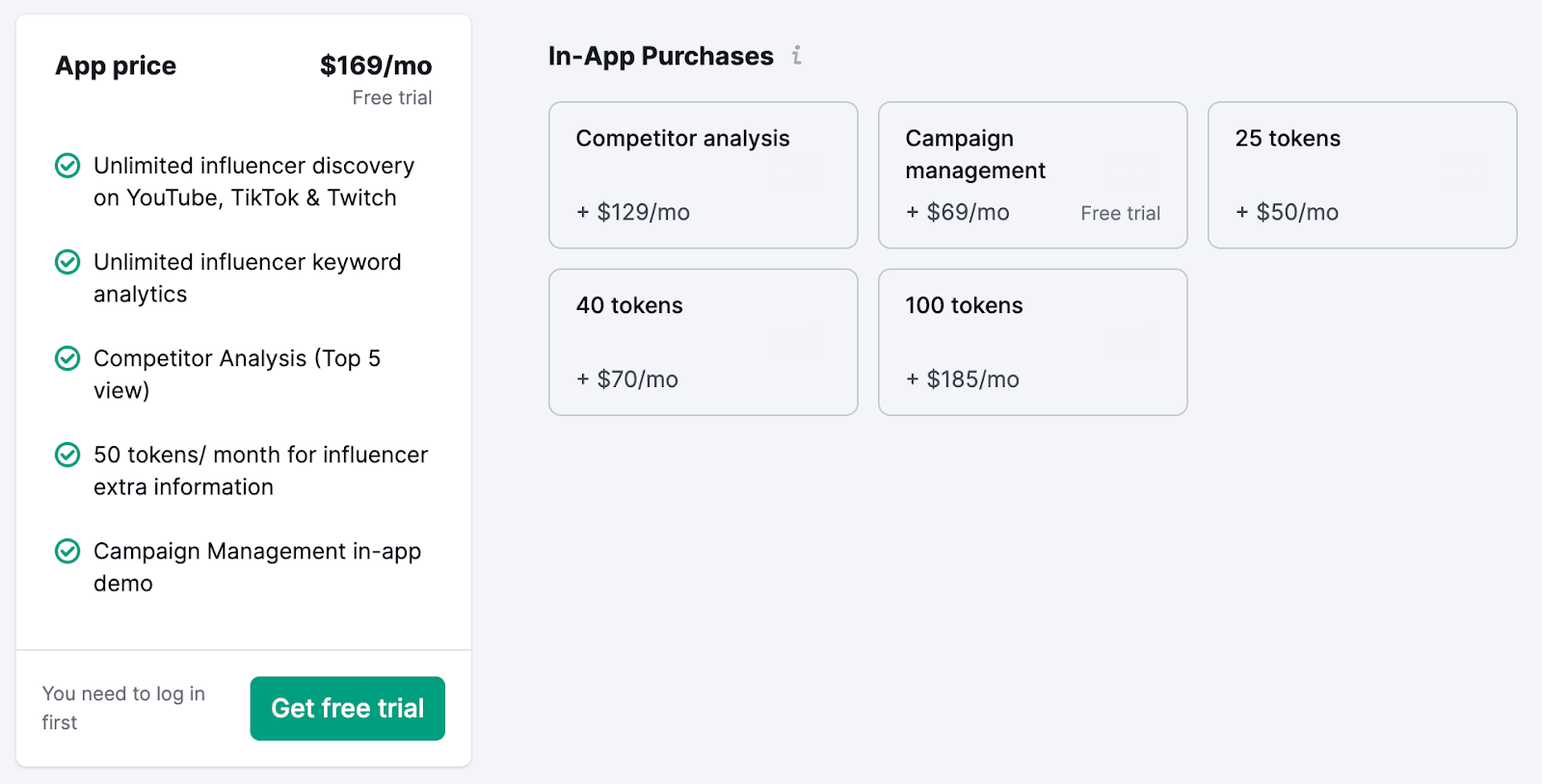
You can use the free seven-day trial to test out the platform.
3. AI Social Content Generator
The AI Social Content Generator helps you create social media content in just a few clicks.
It can generate a variety of different types of content for Facebook, Instagram, and TikTok, including:
- Social media creative and captions
- Reels, shorts, and video ads
- Product videos
- Memes
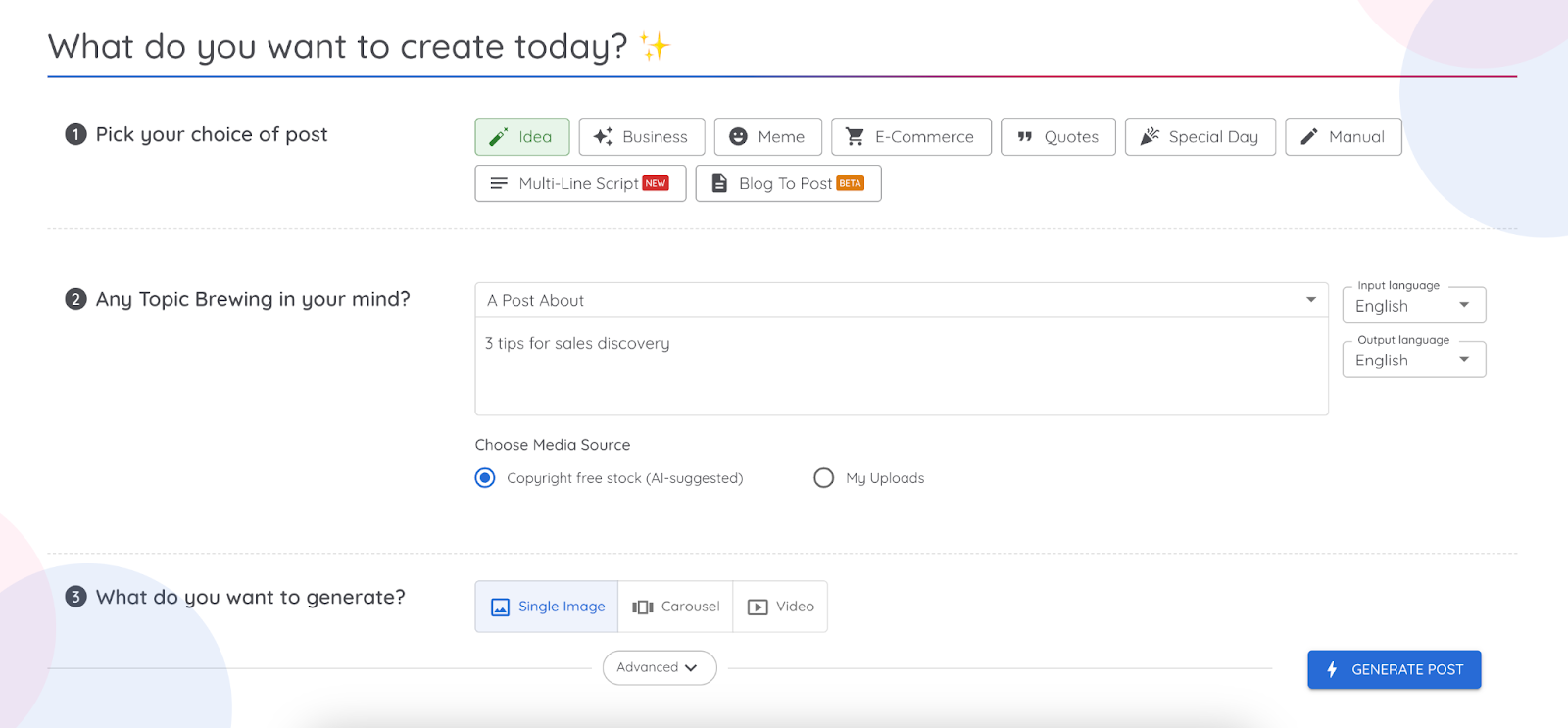
The platform’s AI assistant can even suggest post ideas and create an outline for your social media calendar.
And AI Social Content Generator makes it easy to do a detailed competitive analysis. So you can get an in-depth understanding of your competition’s social media strategy and adapt accordingly.
What We Like
There are a few different tools out there that can generate social media content using AI. But this one lets you add your brand colors and fonts and upload your own designs. So it can generate creative that matches your brand style.
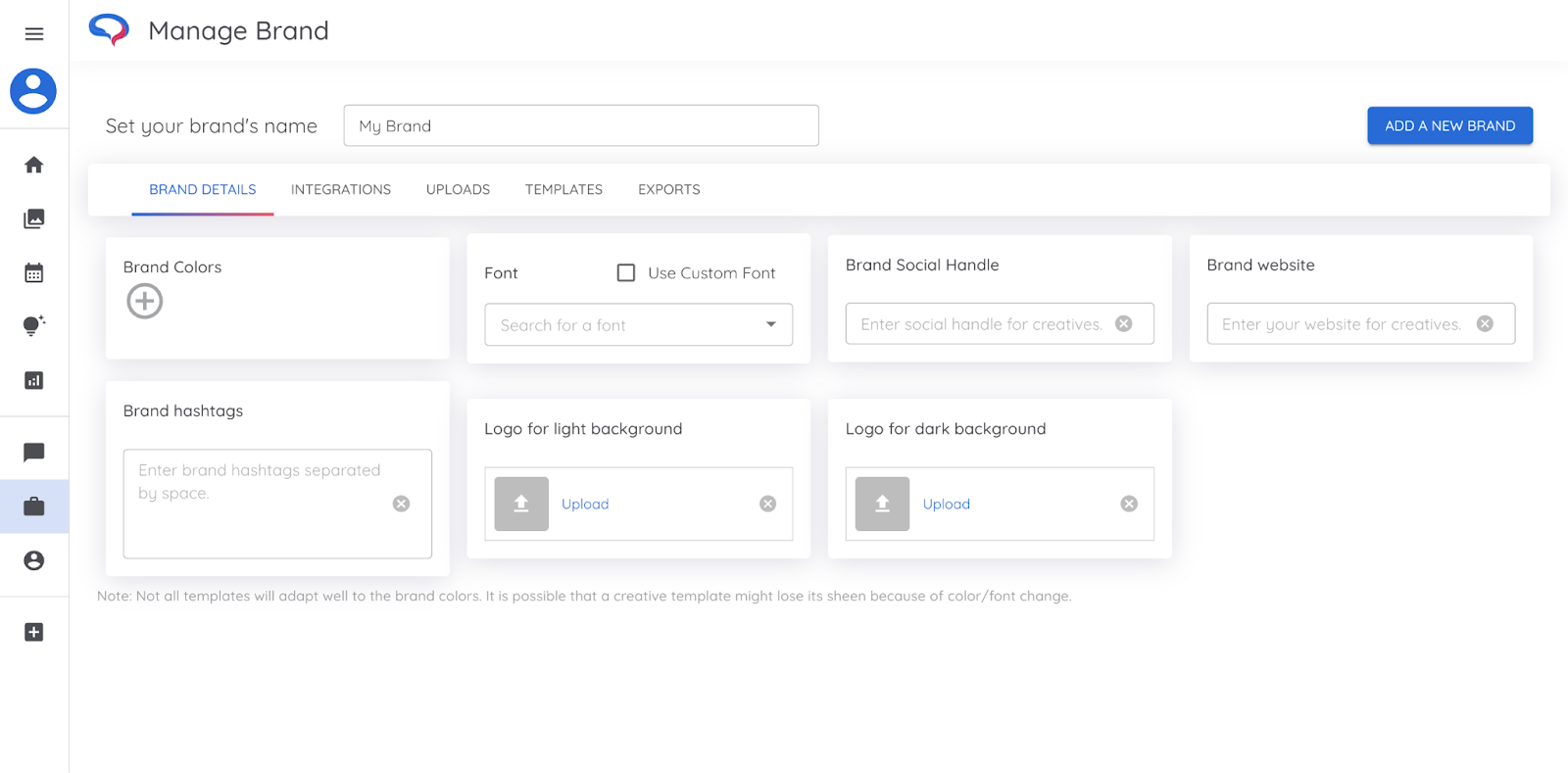
Pricing
The AI Social Content Generator app costs $35/month in the Semrush App Center. An in-app purchase for AI Social Content Generator Plus is also available at $20/month.
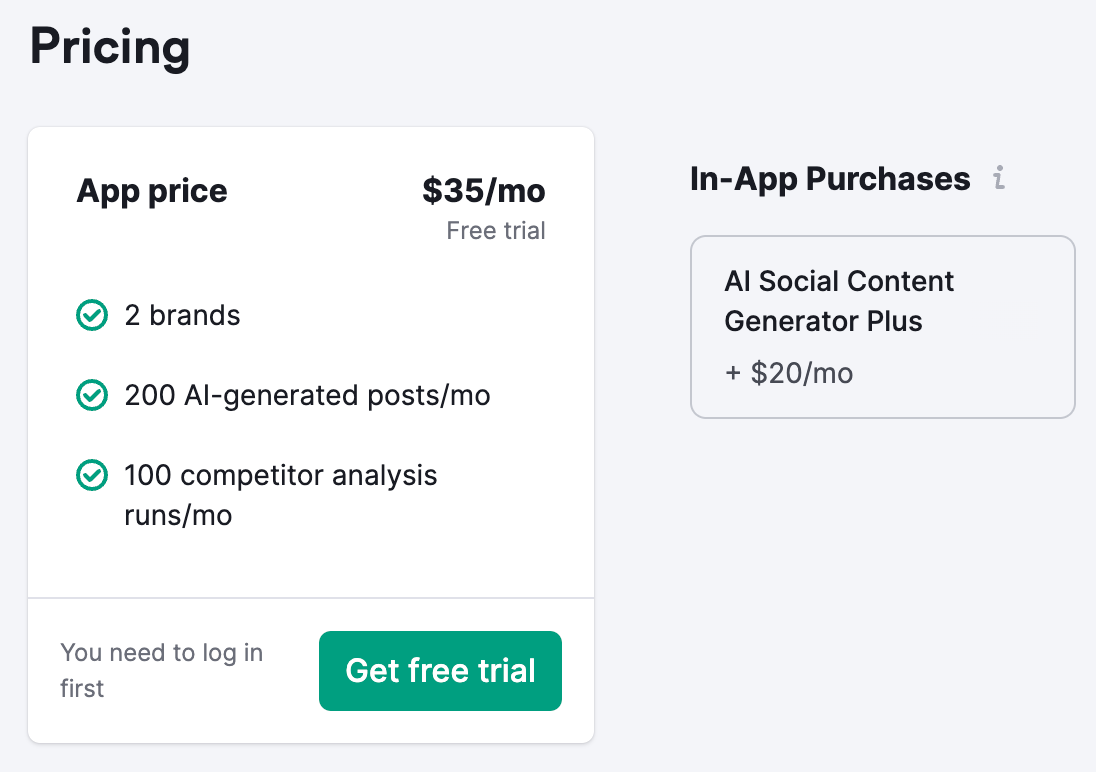
4. Social Content Ideation
The Social Content Ideation tool is an AI-powered tool generating strong content ideas across a variety of topics and helps create that content for specific social media networks.
With AI, you can effortlessly brainstorm ideas, generate posts with images, and refine any content piece, whether generated by you or by AI. Your vision, perfectly realized.
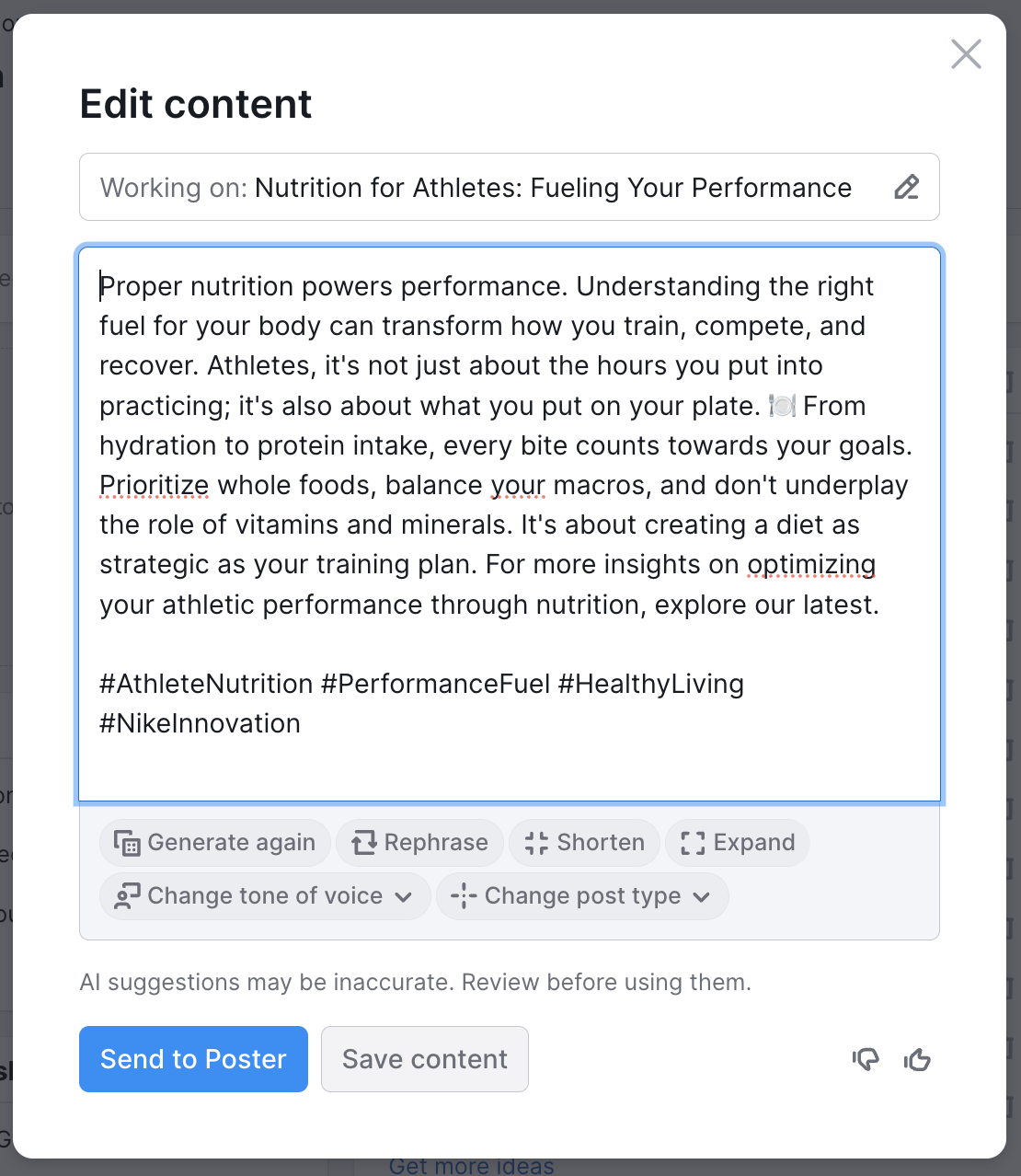
What We Like
The Social Content Ideation tool allows you cover the full social content creation workflow with the help of artificial intelligence.
Specifically, here’s what the tool can do for you:
- Brainstorm with AI: Just add your URL, and receive back a plan with +100 social post ideas/day, categorized by topics.
- Generate copy: The AI crafts posts for you based on your URL and chosen topic in seconds.
- Stand out visually: Instantly craft unique images for your posts that match your brand's look and feel with AI.
- Reshape: Not quite right? Edit and refine any content piece, whether generated by you or AI. Your vision, perfectly realized.
- Craft your perfect social media calendar: Integrate your Semrush Social subscription to directly post and schedule all posts.
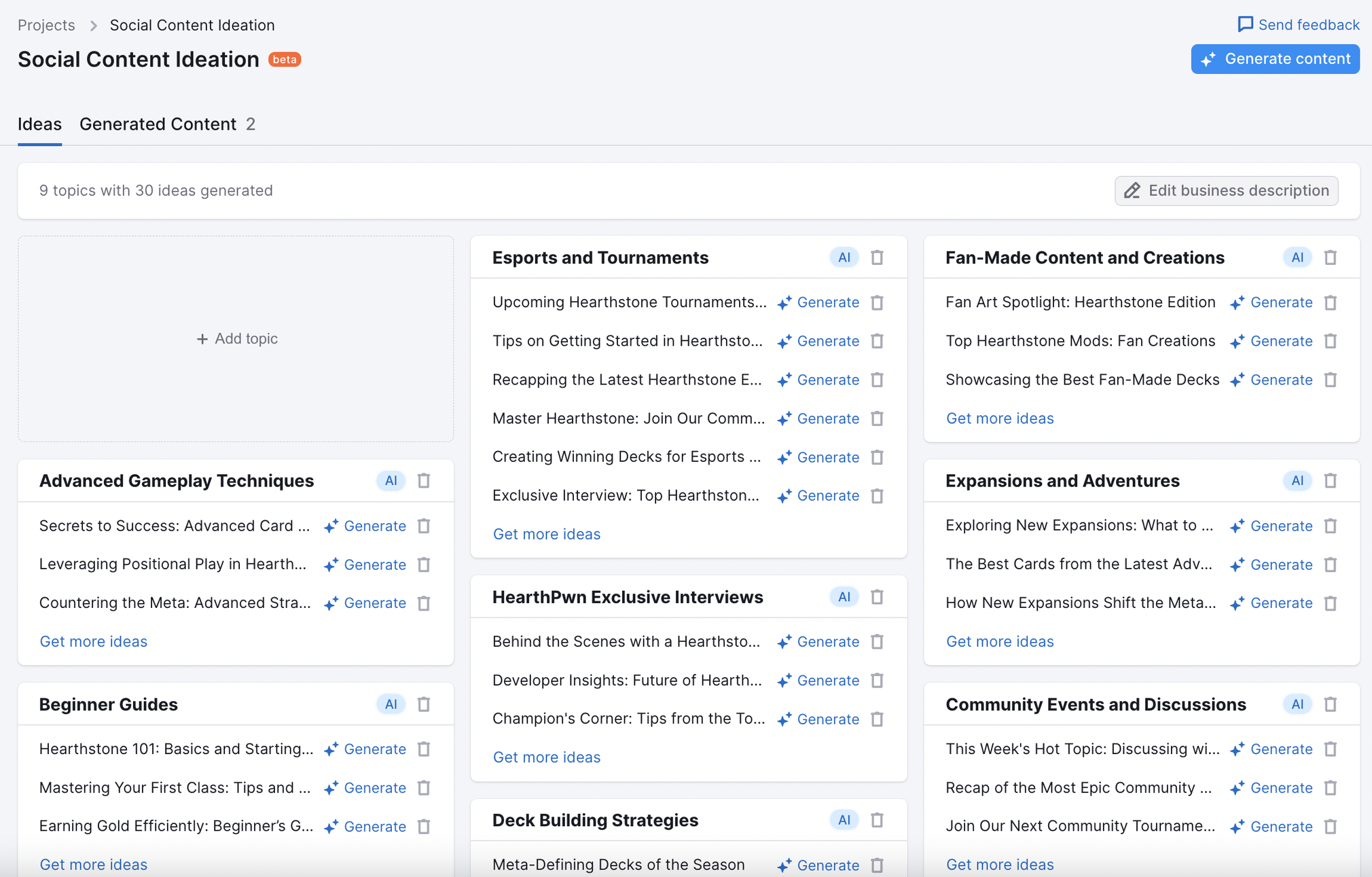
Pricing
This tool is currently in Beta, meaning it’s available to all Semrush users for free. As we develop its full functionality, it will be available with a paid subscription, separate from the Semrush Social subscription.
5. Sprout Social
Sprout Social is a social media management platform for small businesses, agencies, and enterprises.
The platform’s intuitive social media scheduling and publishing tools help eliminate some of the tedious manual work involved in executing social campaigns. And the analytics features allow you to review the performance of specific posts and campaigns.
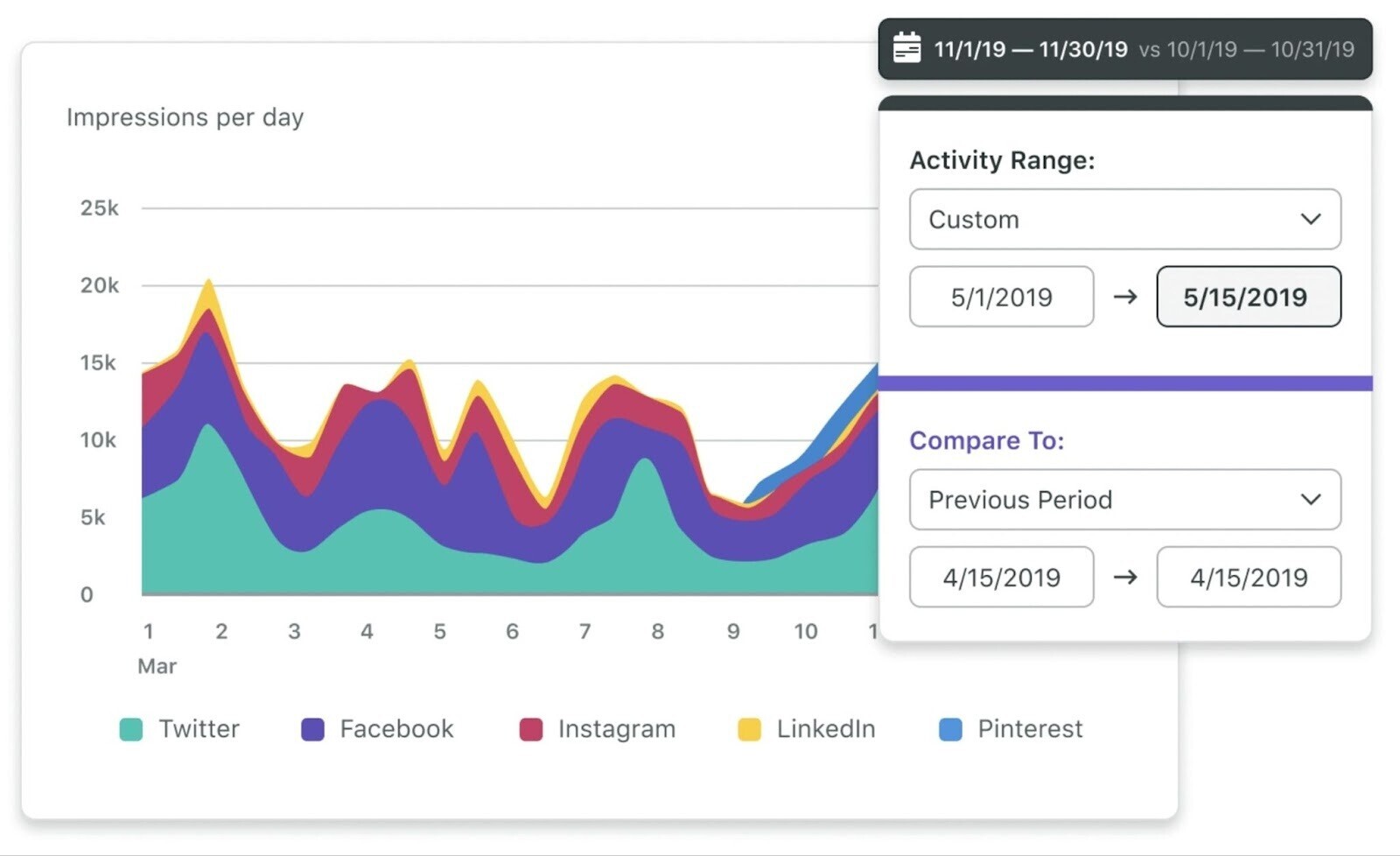
Team collaboration is simplified through content approval workflows. And through a shared content calendar and campaign planning tools.
The platform also offers a powerful social listening feature that helps you stay on top of brand sentiment and industry changes. And allows you to keep an eye on the competition.
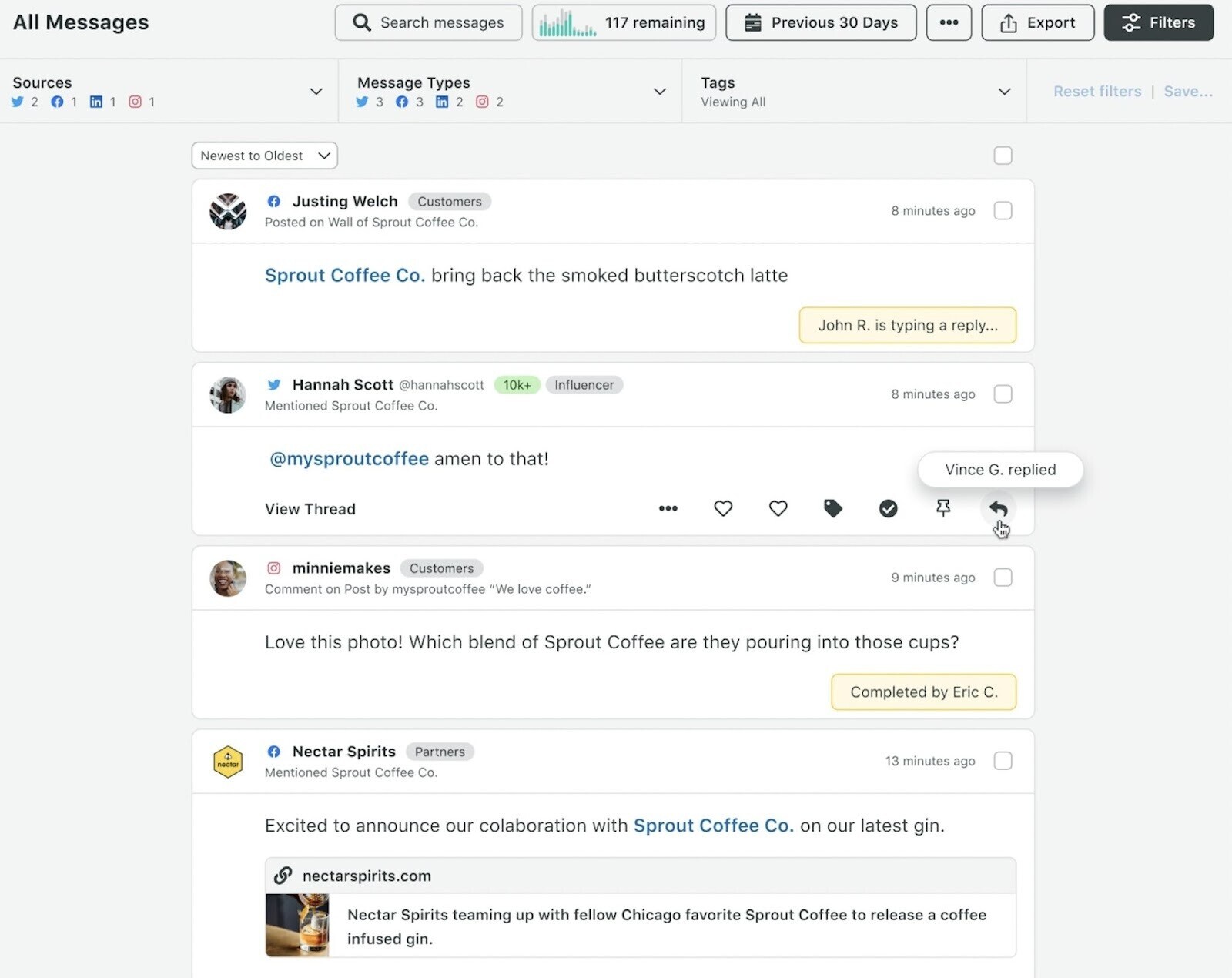
What We Like
Real-time notifications allow you to see which team members are working on which tasks (e.g., replying to specific messages or comments). To prevent unnecessary work and missed opportunities.
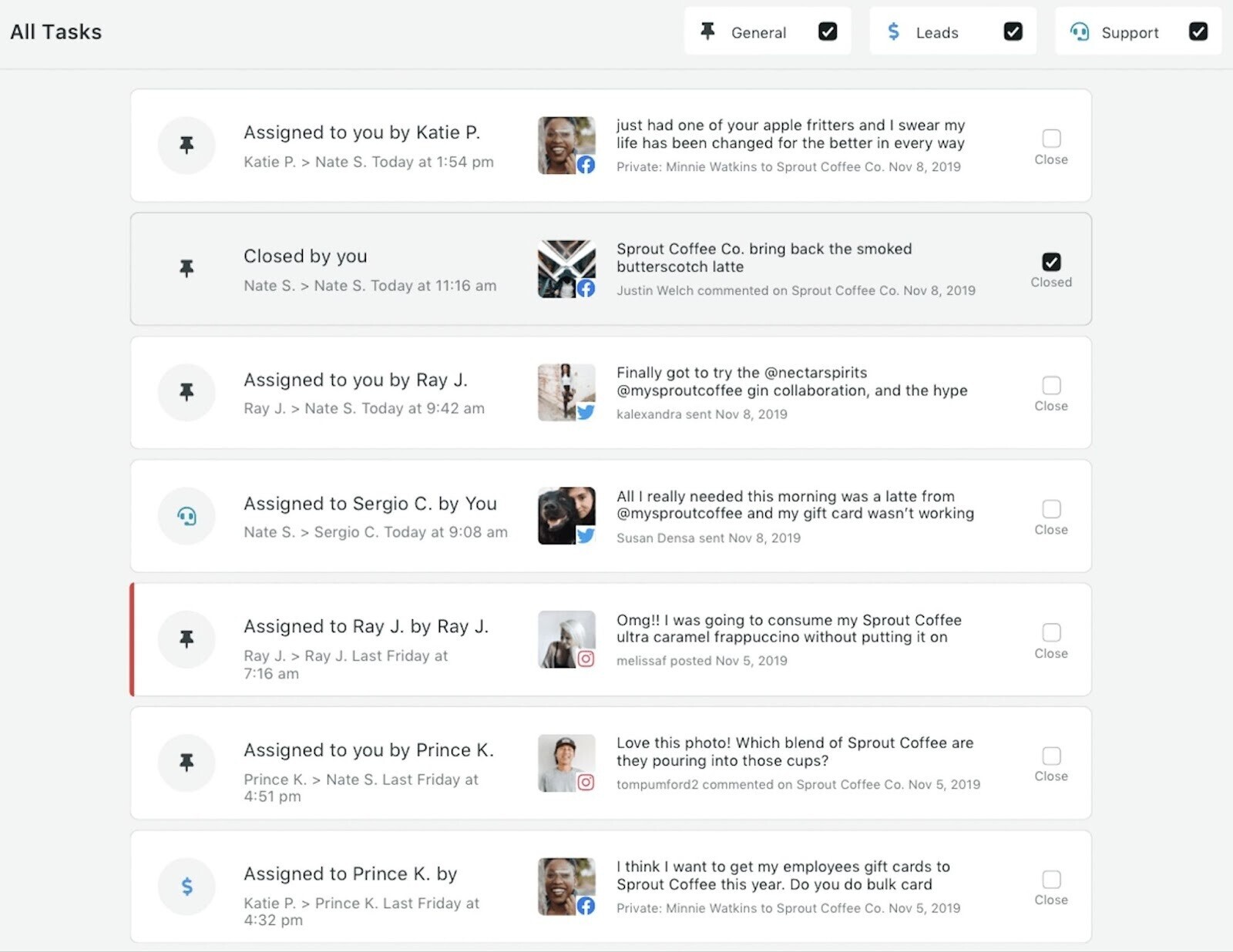
Price
Sprout Social offers four plans:
- Standard: $249 per month + $199 per month for each additional user
- Professional: $399 per month + $299/month for each additional user
- Advanced: $499 per month + $349 per month for each additional user
- Enterprise: custom pricing
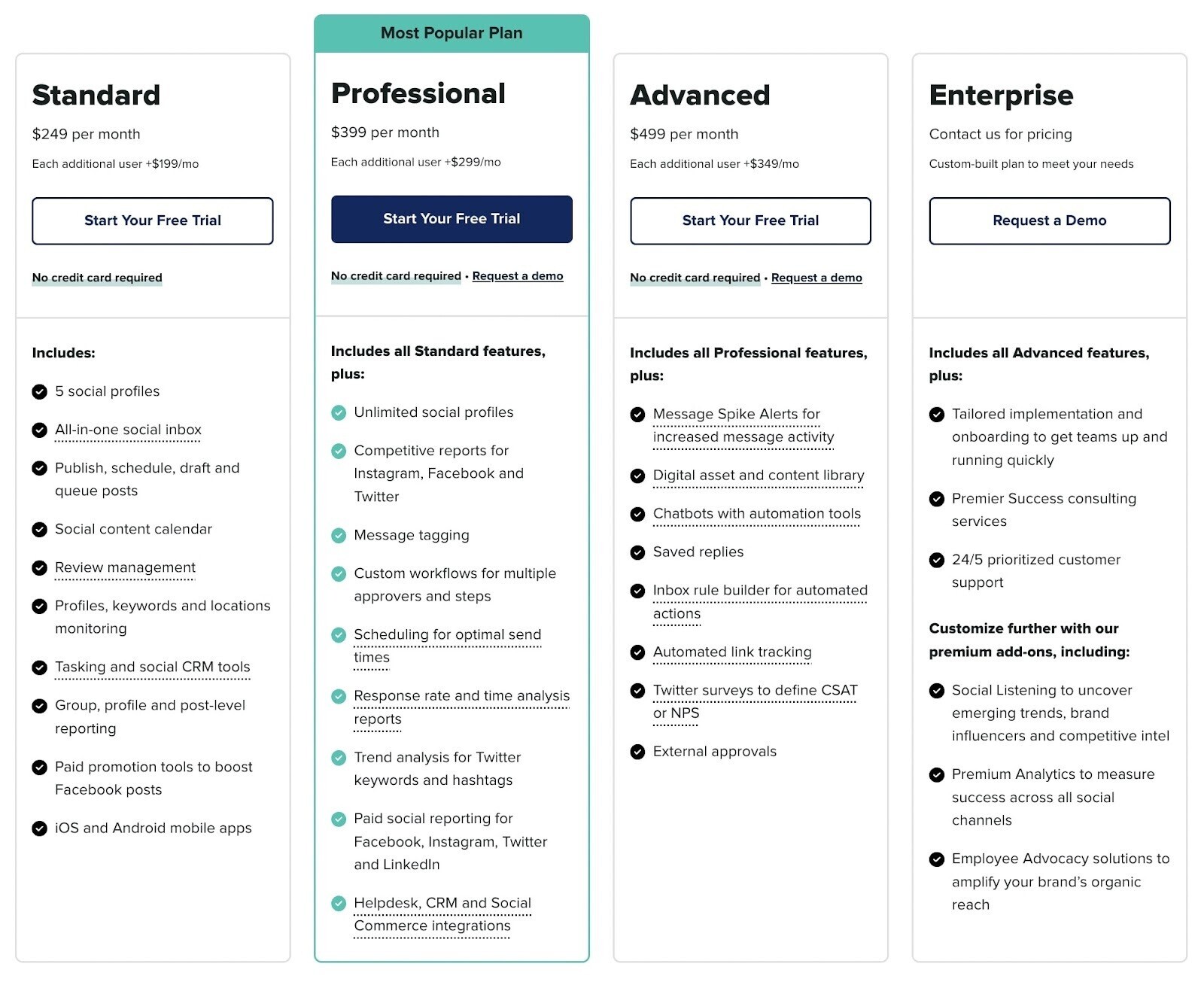
There’s also a free 30-day trial you can use to test out the platform.
6. Agorapulse
Agorapulse offers a tool for social media management, monitoring, and reporting aimed at brands and agencies.
It lets you organize all your social media content using an intuitive, drag-and-drop schedule builder. And lets you easily reschedule previously published content to get it in front of your target audiences quickly.

The unified social media inbox allows you to manage incoming messages and comments from six social media channels in a single location.
You have the option to tag and categorize social media followers and fans. Plus, you can add internal notes for your team to provide context for every conversation.
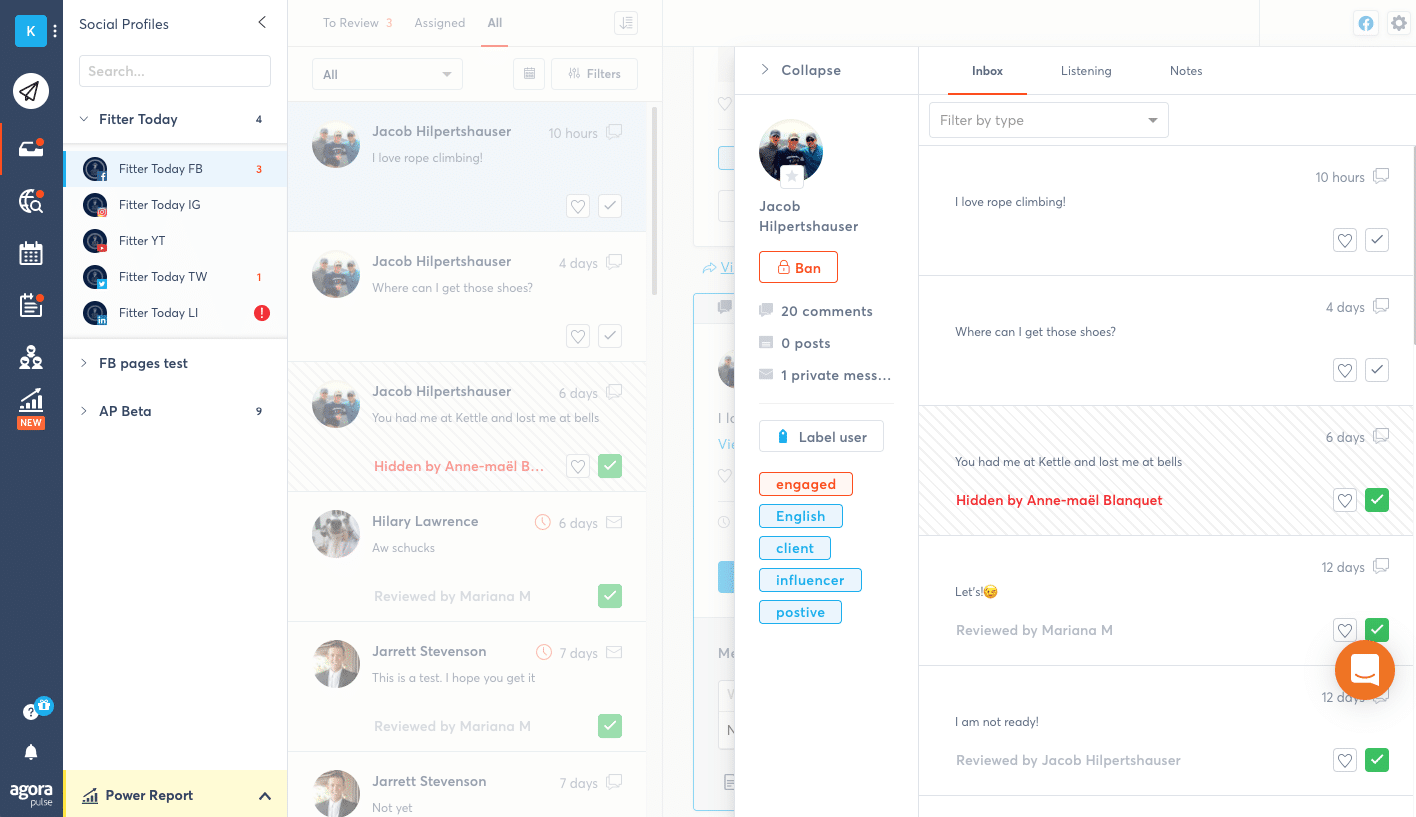
Agorapulse also offers a mobile app you can use to manage your social media accounts on the go.
What We Like
Saved replies and one-click translation help you answer frequently asked questions and manage issues quickly. And the built-in image cropping and video thumbnail customization tools help to make your social content look just right.
Price
Agorapulse offers the following plans:
- Free: limited to one user, three social profiles, and 10 scheduled posts
- Standard: 69€ per month (around $76 per month)
- Professional: 99€ per month (around $109 per month)
- Advanced: 149€ per month (around $163 per month)
- Custom: individualized pricing
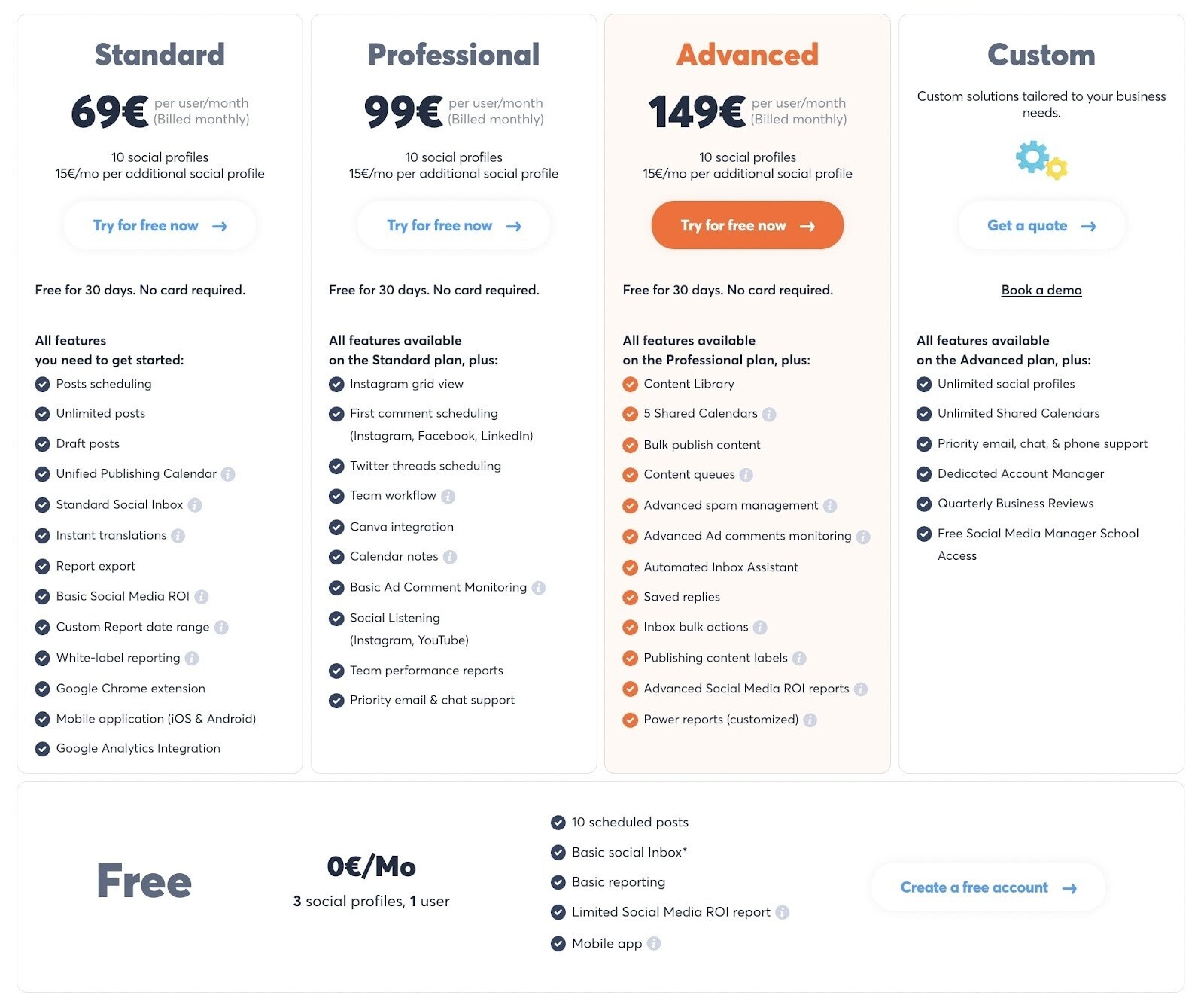
You can also try out the Standard, Professional, and Advanced plans free for 30 days.
7. Hootsuite
Hootsuite is a social media management platform that offers a host of social media content tools to help marketers streamline their social media marketing efforts.
The social media calendar and planner allow you to publish content to your most popular social media channels from a single dashboard. And the bulk scheduler enables you to schedule hundreds of posts at once.
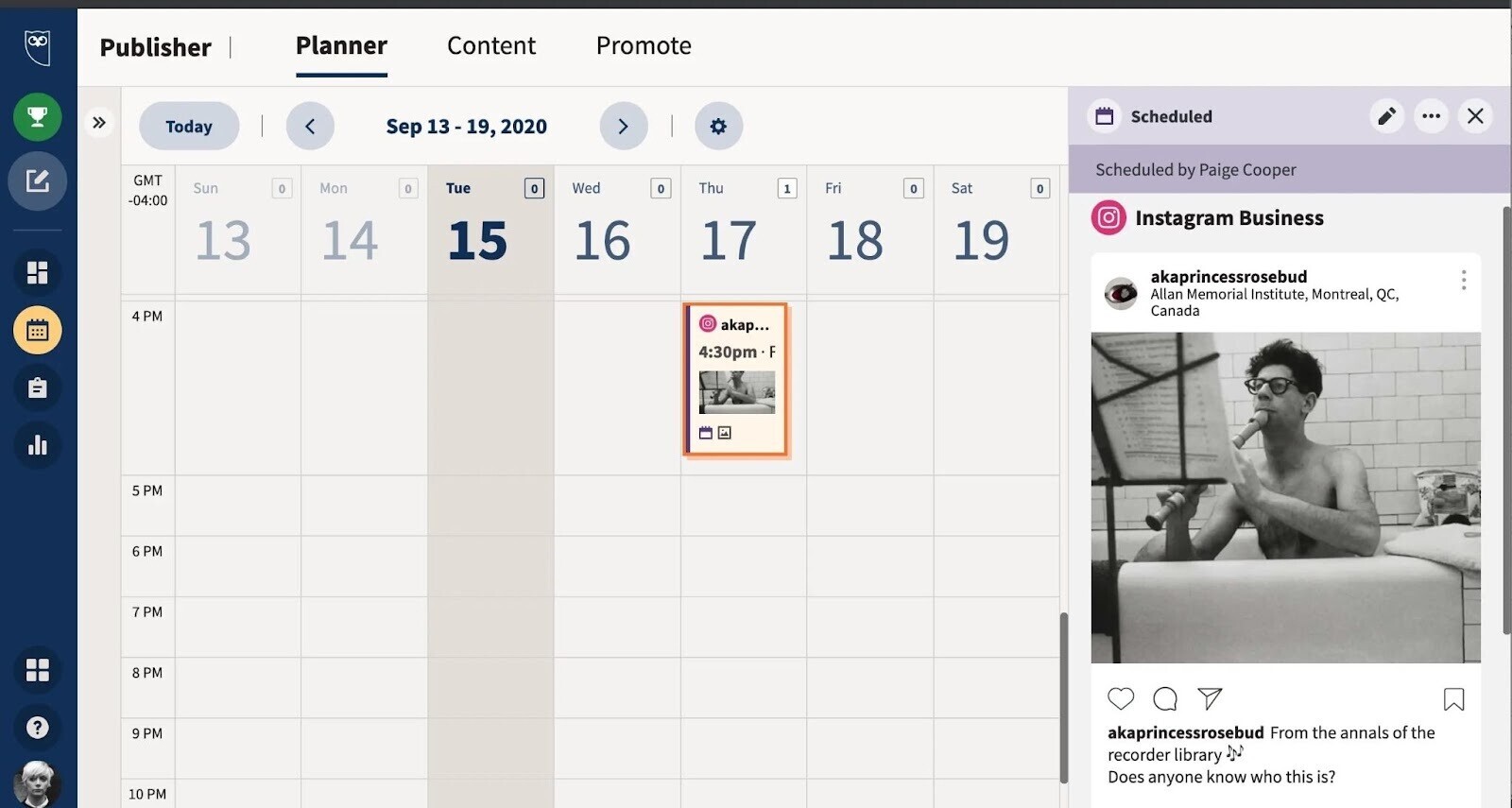
Then there’s Hootsuite Amplify—an employee advocacy tool that makes it easy for employees to share your content and amplify your brand message. It’s available as an add-on for Hootsuite’s Business and Enterprise plans.
Hootsuite also lets you manage your social advertising campaigns across Facebook, Instagram, and LinkedIn directly within the tool. To prevent you from having to use multiple tools to stay on top of your ad campaigns.
What We Like
OwlyWriter AI, Hootsuite’s AI assistant, can help get your creative juices flowing by generating post ideas and crafting engaging captions. It’s free to use for a limited time.
Price
Hootsuite offers a free 30-day trial and four plans:
- Professional: $99 per month
- Team: $249 per month
- Business: $739 per month
- Enterprise: custom pricing
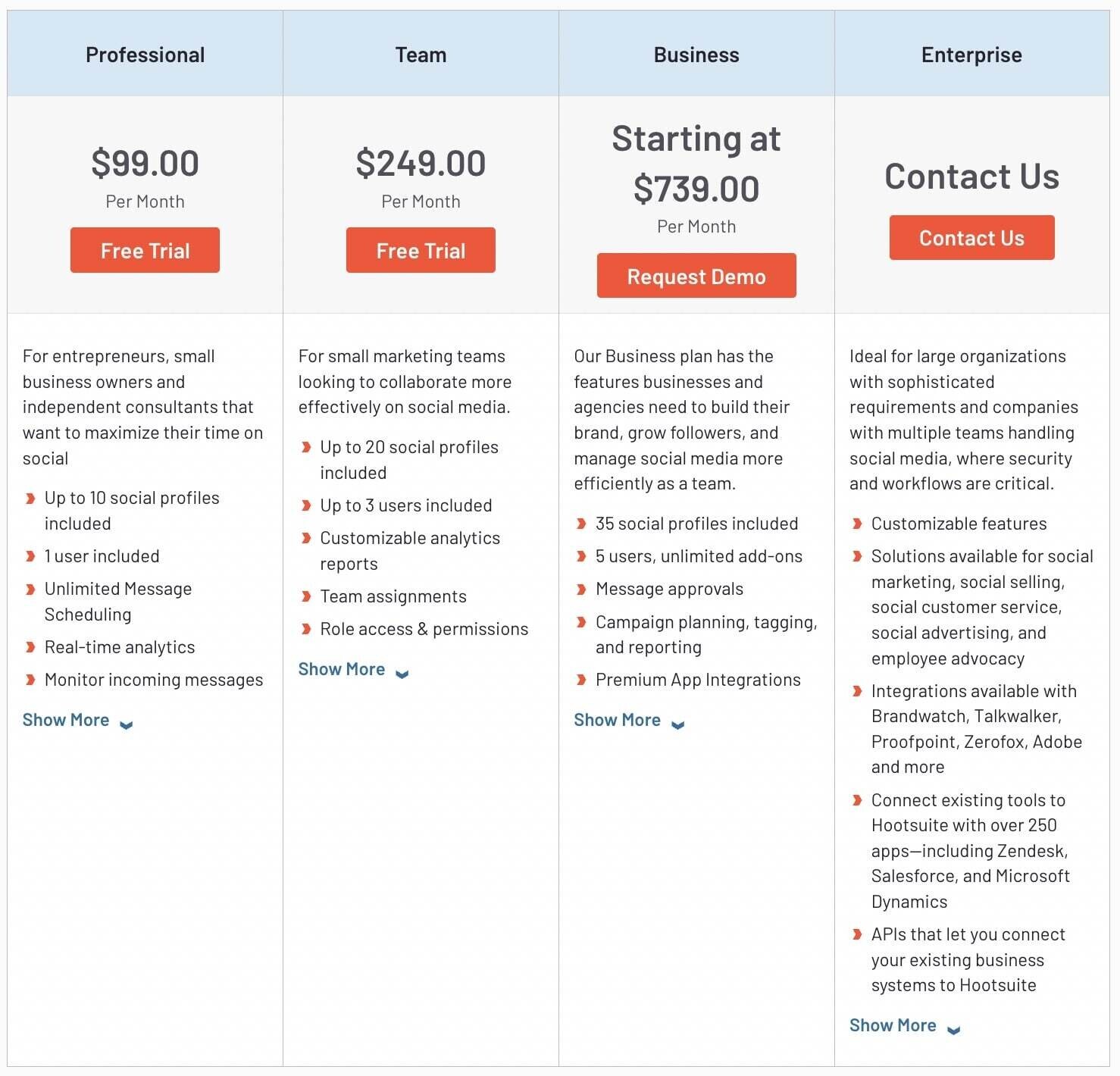
You can get 20% off the Professional and Team plans if you opt to skip the free trial offer.
8. Buffer
Buffer is a simple social media management tool that includes scheduling, publishing, engagement, and analytics features.
You use it to draft and schedule posts across some of the most popular social media networks, including Facebook, Instagram, Twitter, LinkedIn, and TikTok.
The software’s social engagement features allow you to see and reply to all your unanswered comments from one central location. Plus, it alerts you about important conversations like questions or negative comments.
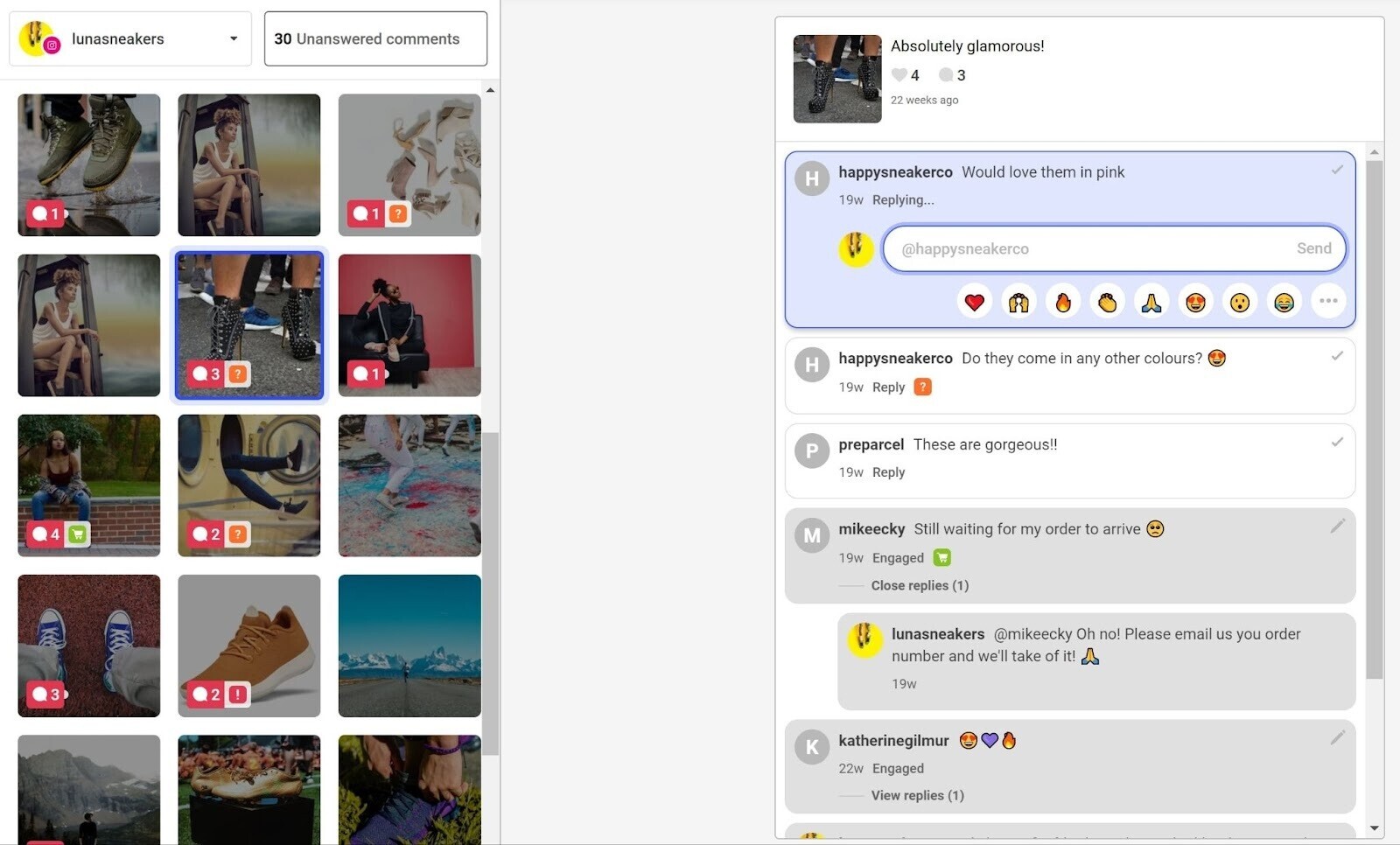
There’s also a built-in AI assistant that can help you brainstorm post ideas, write and rewrite social copy, and repurpose your existing posts.
What We Like
Buffer’s Start Page tool gives you a quick way to build a great-looking landing page containing all your best content. And then track engagement using the built-in analytics feature.
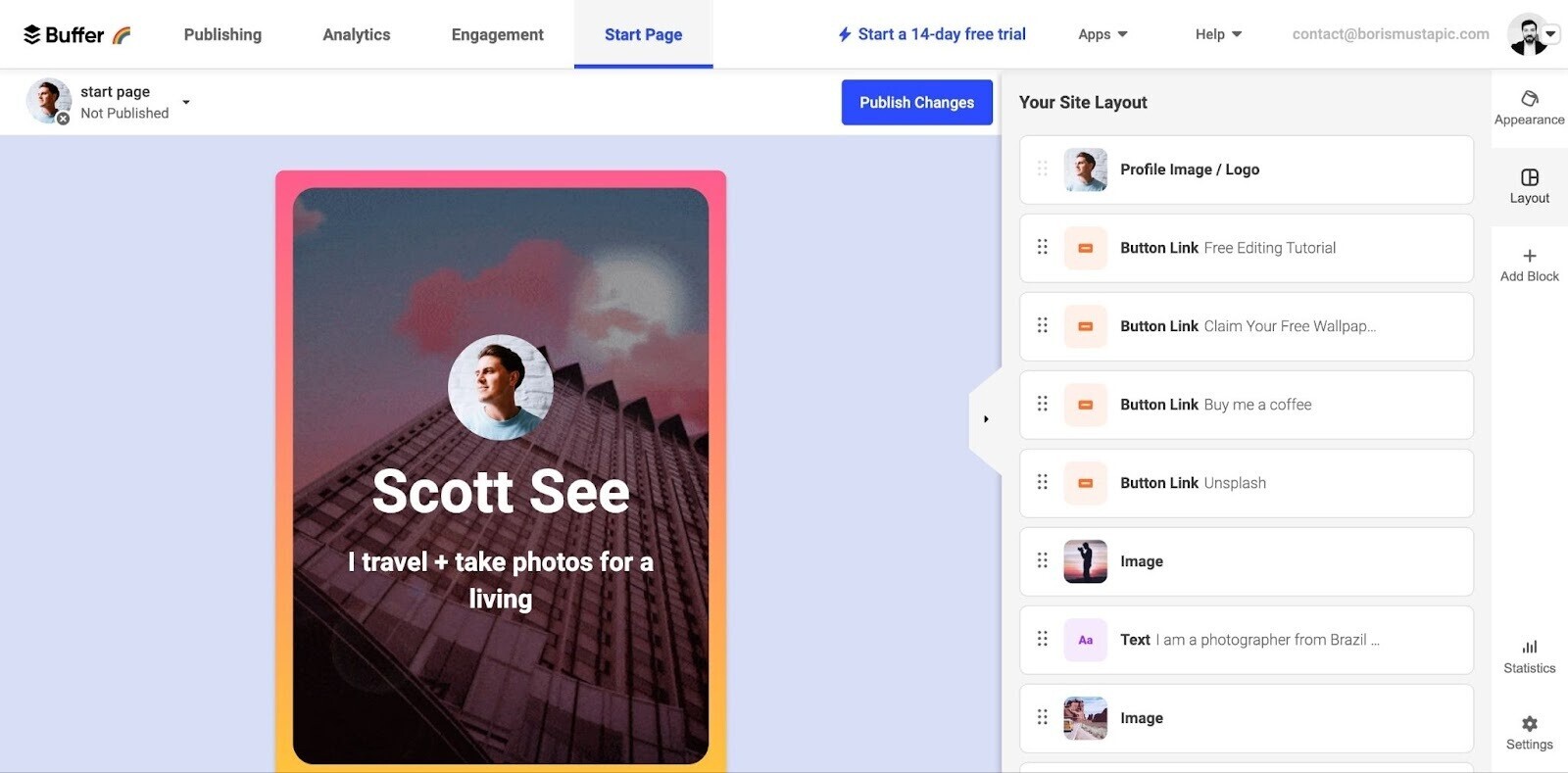
Price
Buffer offers the following plans:
- Free: Limited to three channels
- Essentials: $6 per month for one channel + $6 per month for each additional channel
- Team: $12 per month for one channel + $12 per month for each additional channel
- Agency: $120 per month for 10 channels + $6 per month for each additional channel
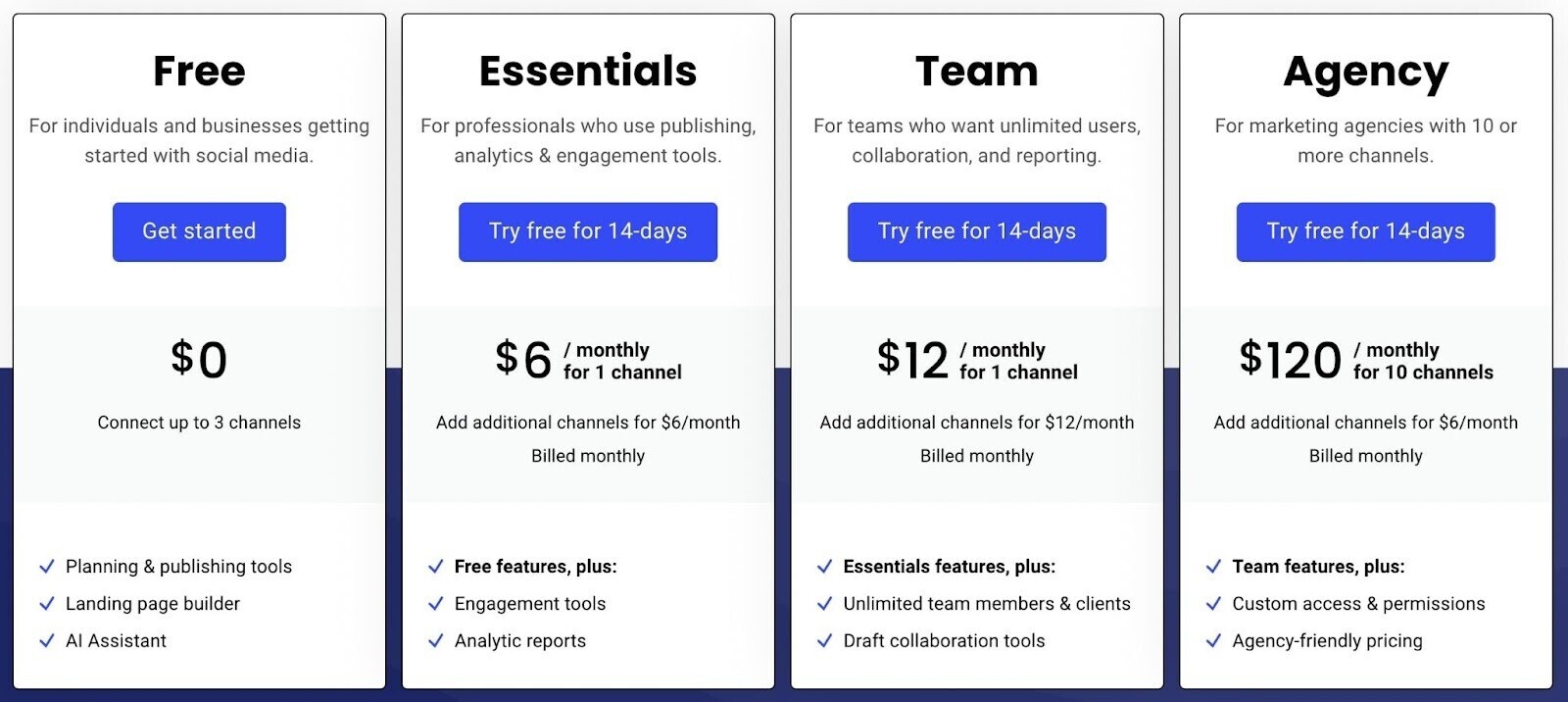
You can try out any of the paid plans for free by taking advantage of the 14-day trial offer.
9. Sendible
Aimed at both agencies and brands, Sendible is a social media tool that supports scheduling and publishing content across Facebook, Instagram, Twitter, LinkedIn, YouTube, TikTok, and Google Business Profile.
It gives you the option to set up individual dashboards for each client. And send daily, weekly, or monthly reports to clients automatically.
The handy calendar view allows you to rapidly edit and rearrange posts.
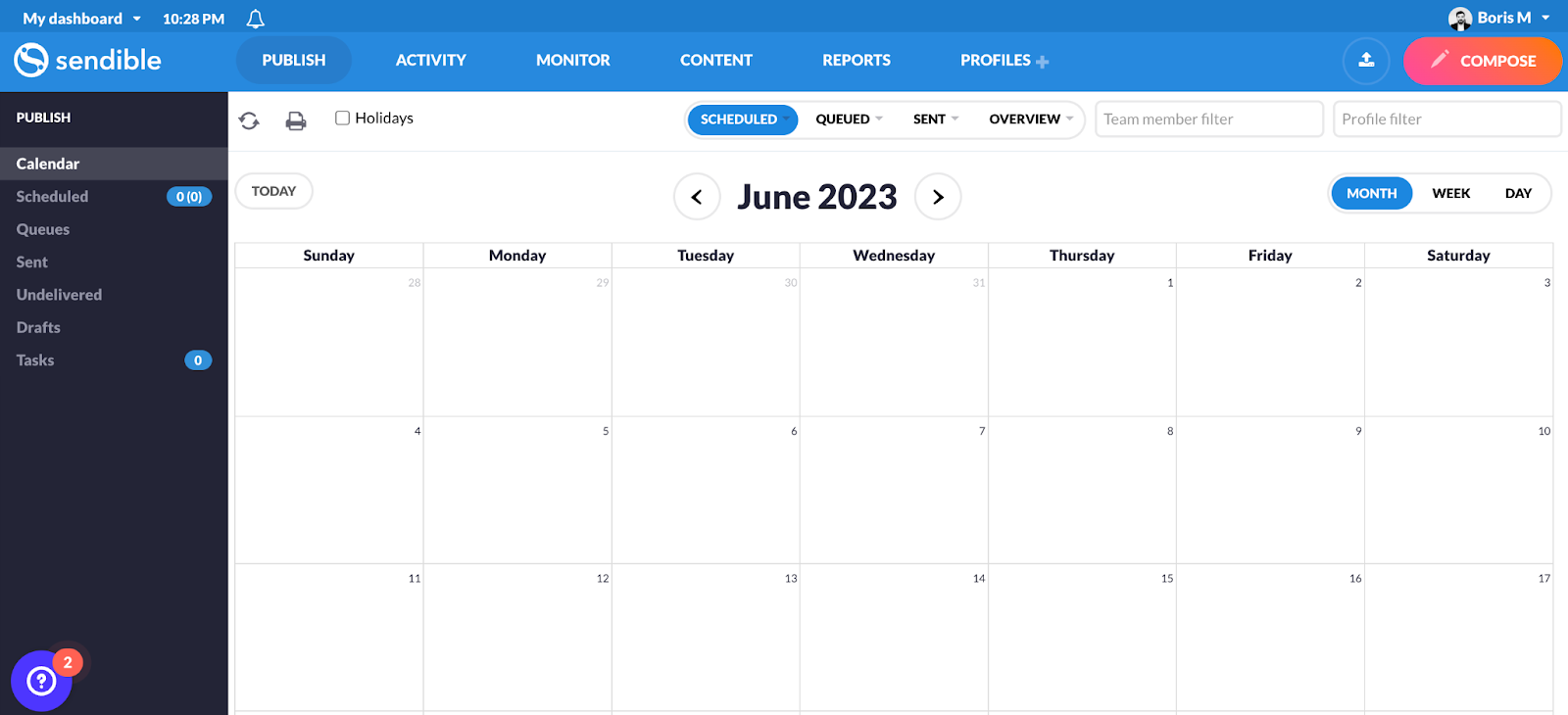
And the centralized inbox makes it easy to look at individual channel feeds and respond to comments.
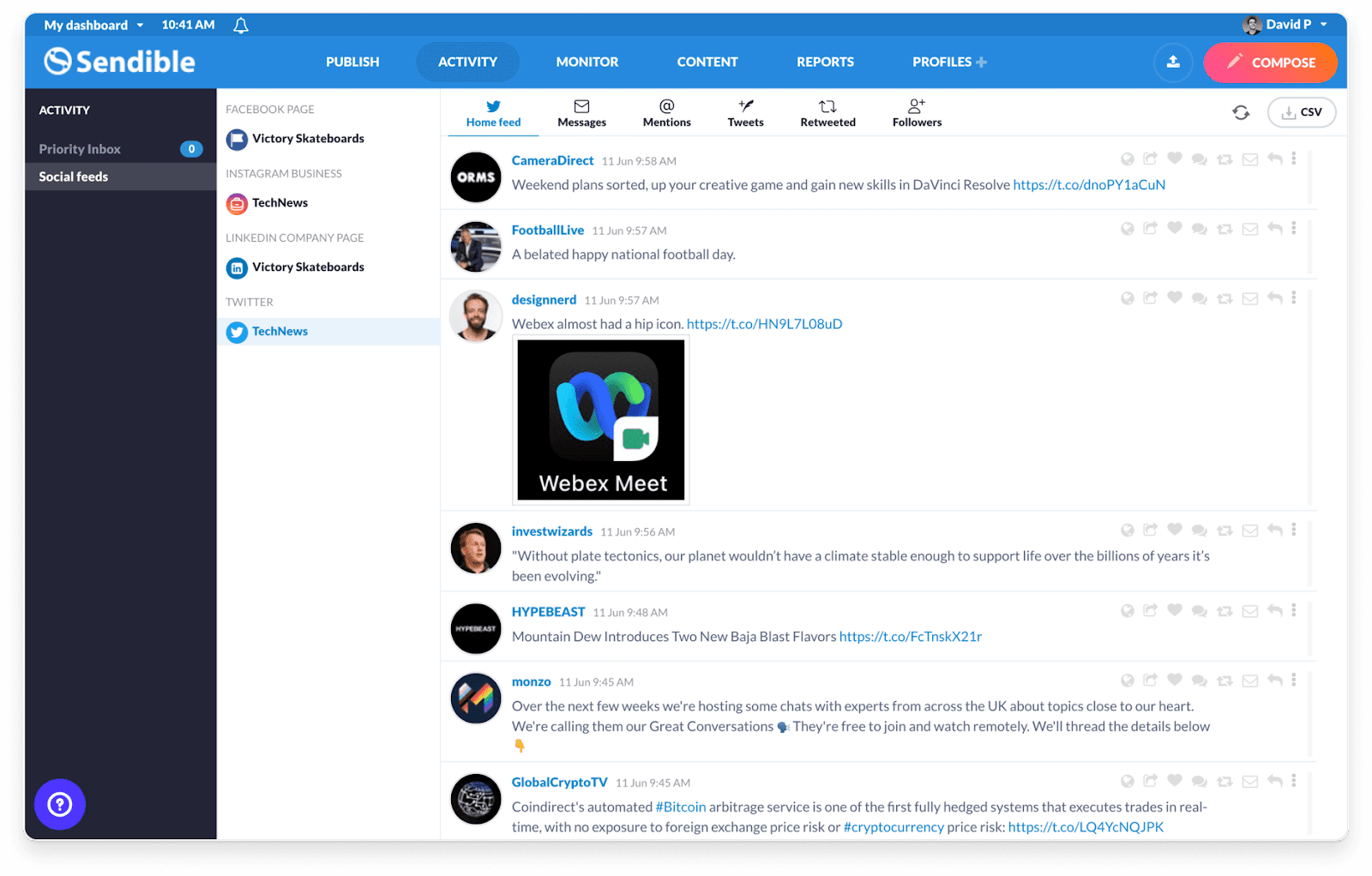
You can also bulk import posts by uploading a CSV file, touch up images using the built-in image editor, and set up shared content libraries to store brand assets and commonly used hashtags.
What We Like
Sendible offers a white-label option you can use to create branded dashboards for clients. Each dashboard can be customized with your brand colors and accessed through your domain.
Clients can then use the dashboard to approve posts and view performance reports.
Price
Sendible offers the following plans:
- Creator: $29 per month
- Traction: $89 per month
- White Label: $240 per month
- Custom: Individualized pricing
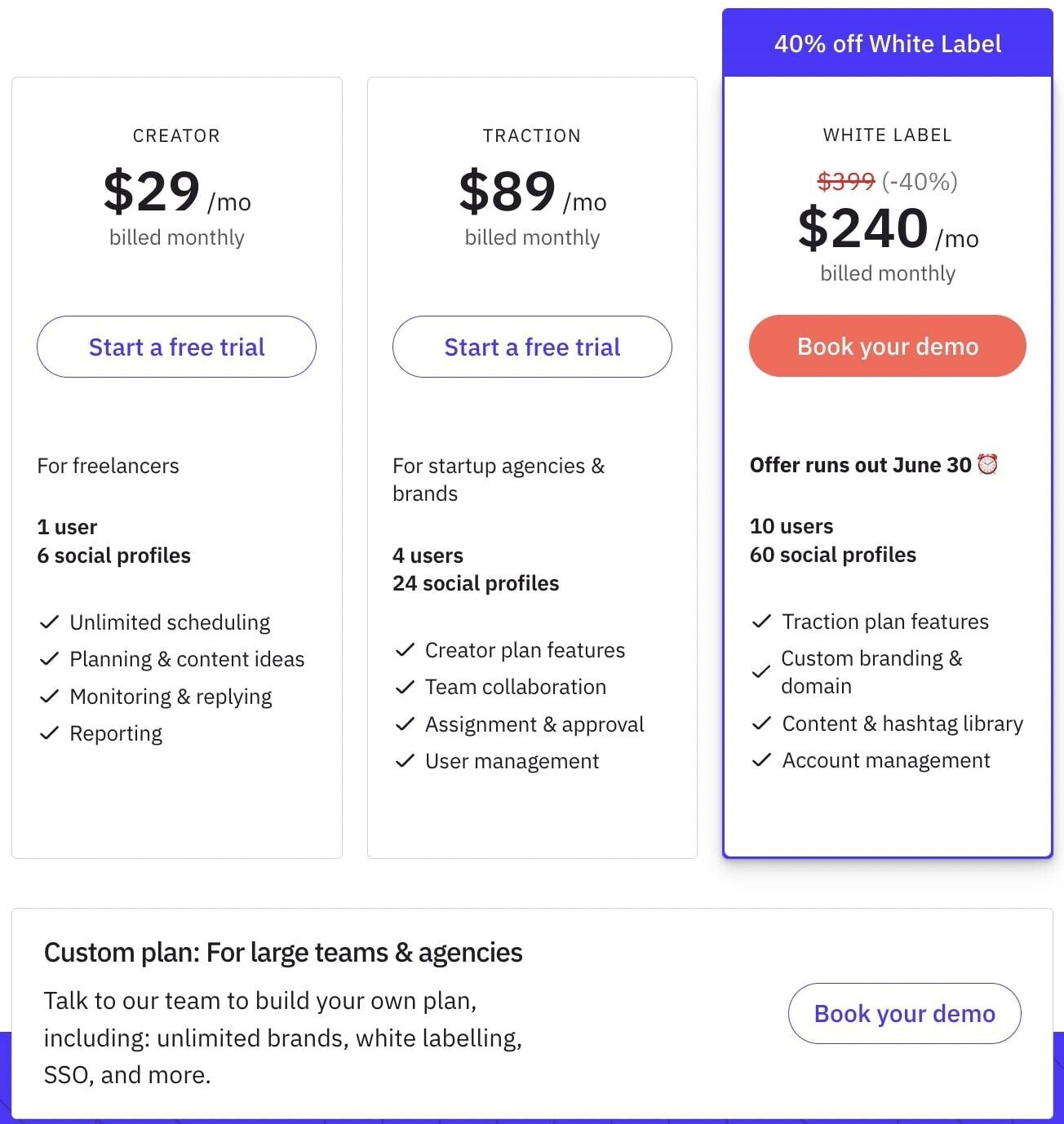
Each plan includes a free 14-day trial.
10. Later
Later offers a suite of tools for creating, scheduling, and publishing content across some of the most popular social media platforms. Like TikTok, LinkedIn, and Instagram.
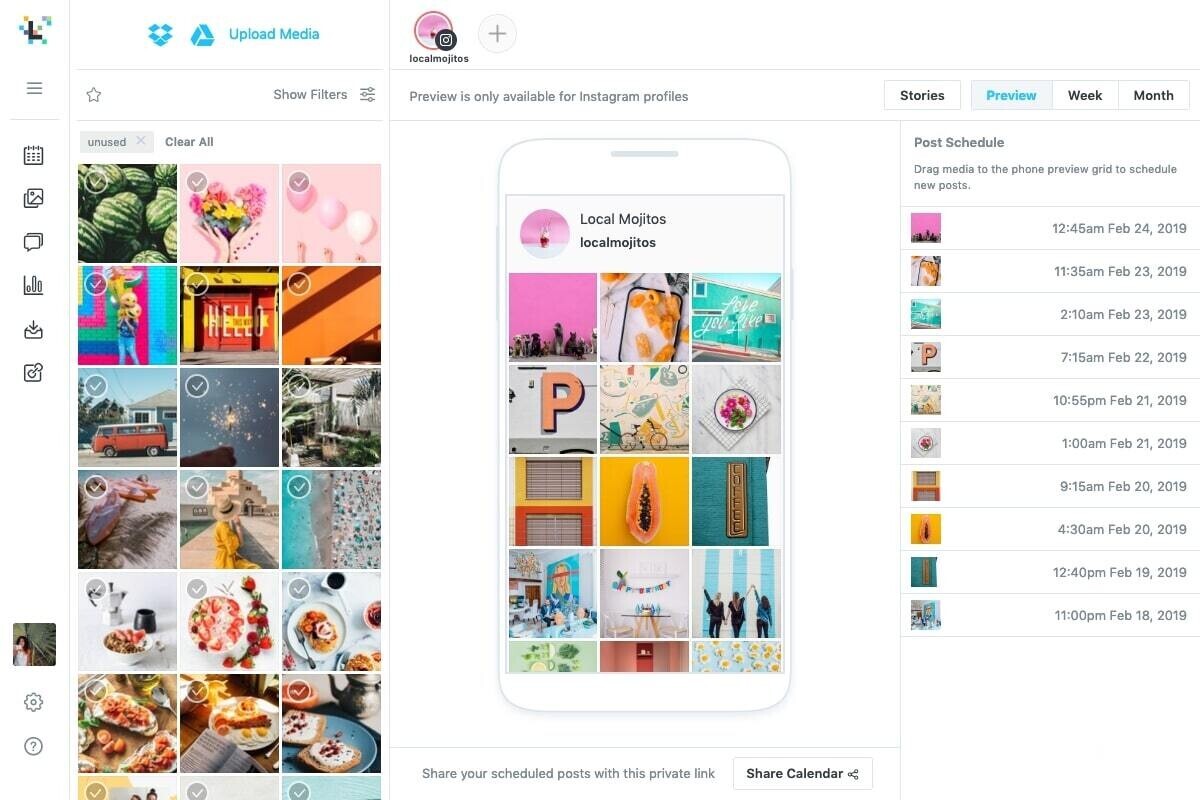
Its content creation tools allow you to search for user-generated content, get hashtag recommendations, and edit photos and videos.
You can use the media library to upload all your media assets. So they’re easily accessible for your entire team.
Later also offers mobile apps that allow you to schedule content on the go. And an AI-powered Caption Writer tool that can quickly generate on-brand captions for your posts.
What We Like
Later’s Linkin.bio tool enables you to create custom “link in bio” pages for Instagram and TikTok to help followers learn more about your brand. And you can choose between multiple page themes, use custom colors and fonts, tag posts, and track clicks.
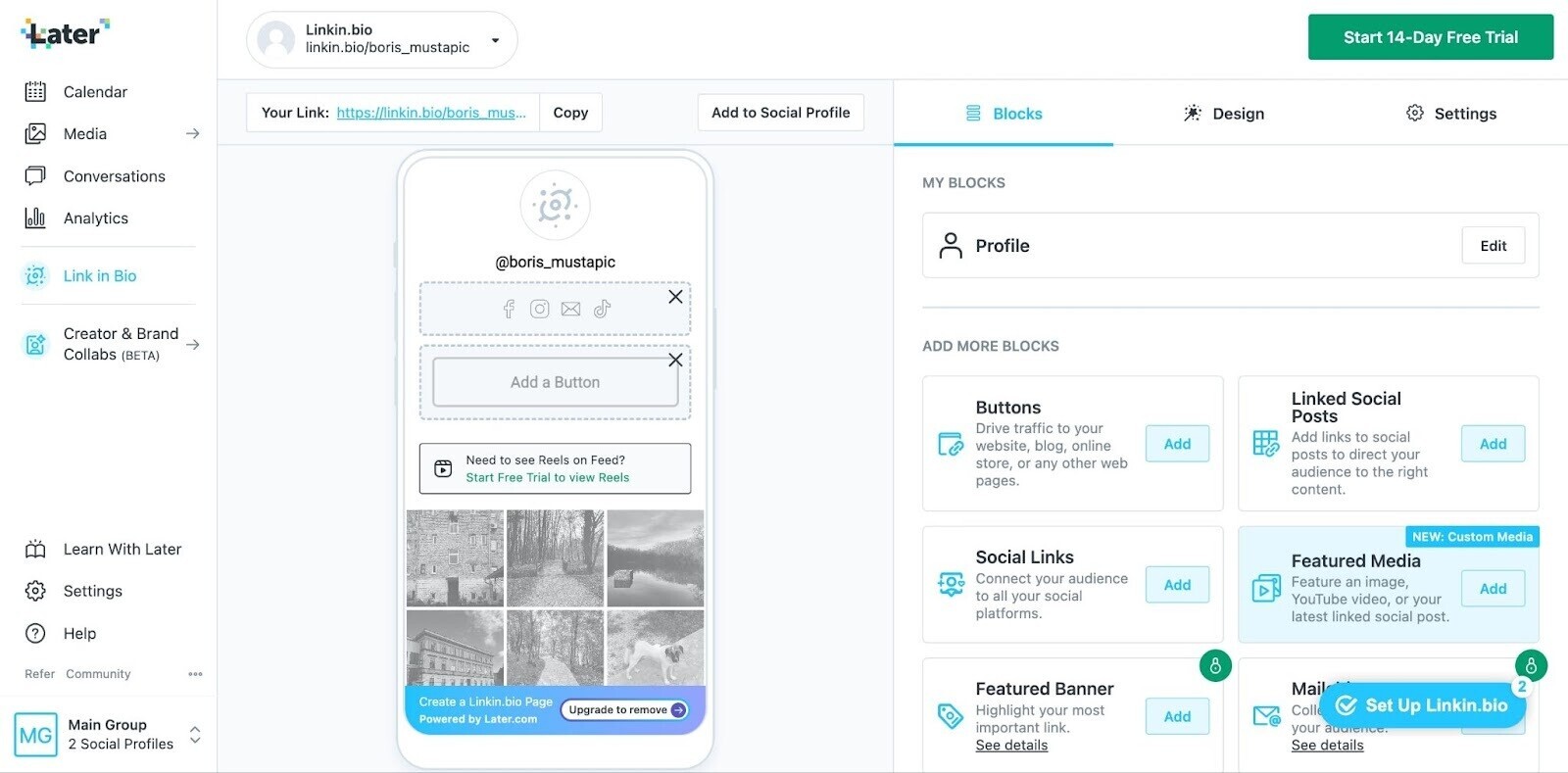
Price
Later offers the following plans, including two that are geared toward agencies:
- Free: limited features
- Starter: $18 per month
- Growth: $40 per month
- Advanced: $80 per month
- Scale 15: $200 per month
- Scale 30: $400 per month
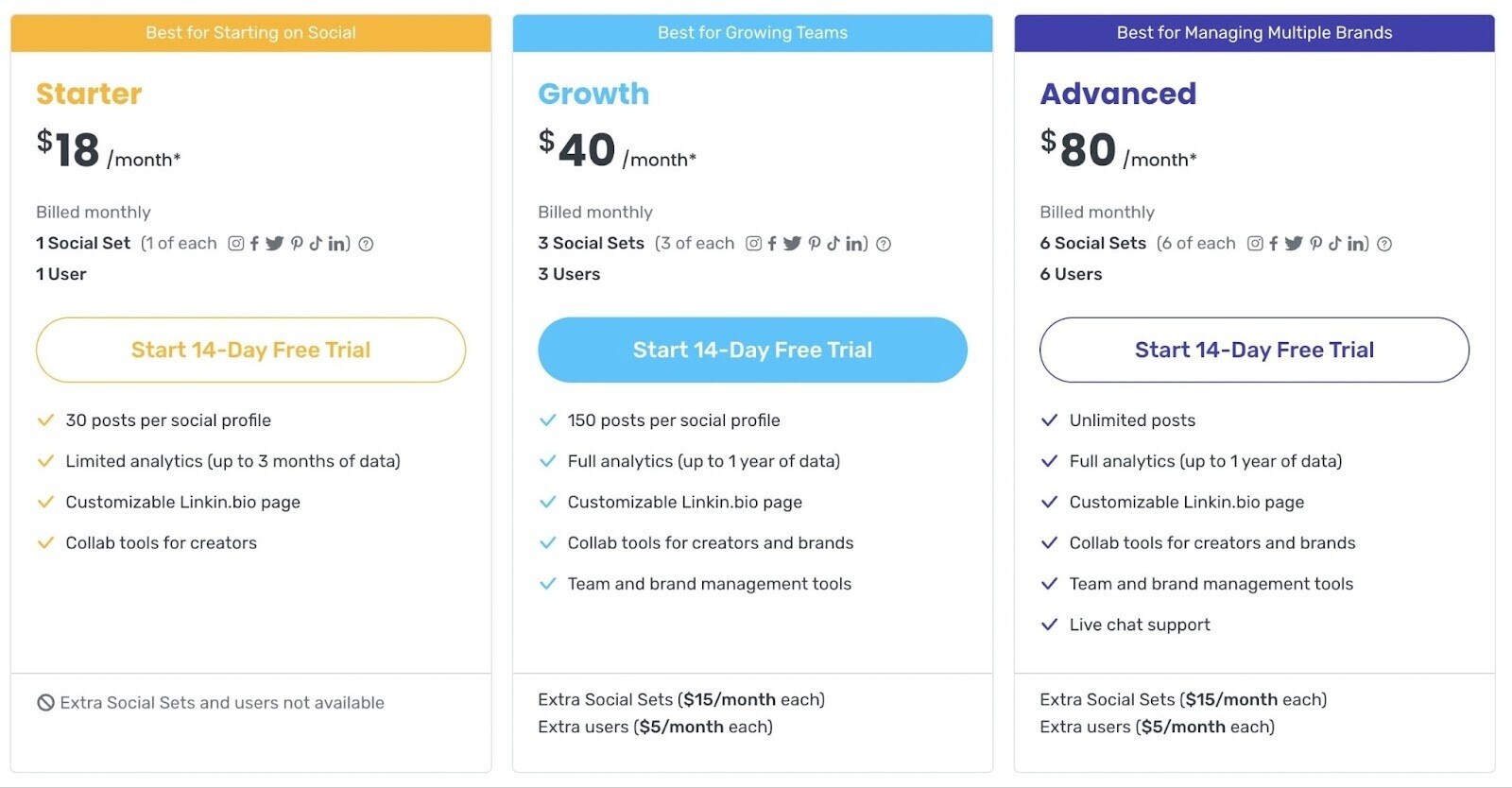

A free 14-day trial is available for all plans.
11. SocialPilot
SocialPilot is a social media marketing and management software for small to medium-sized businesses (SMBs), multi-location brands, and agencies. And supports scheduling and posting content across all major social media platforms, including Facebook, Instagram, Twitter, LinkedIn, and TikTok.
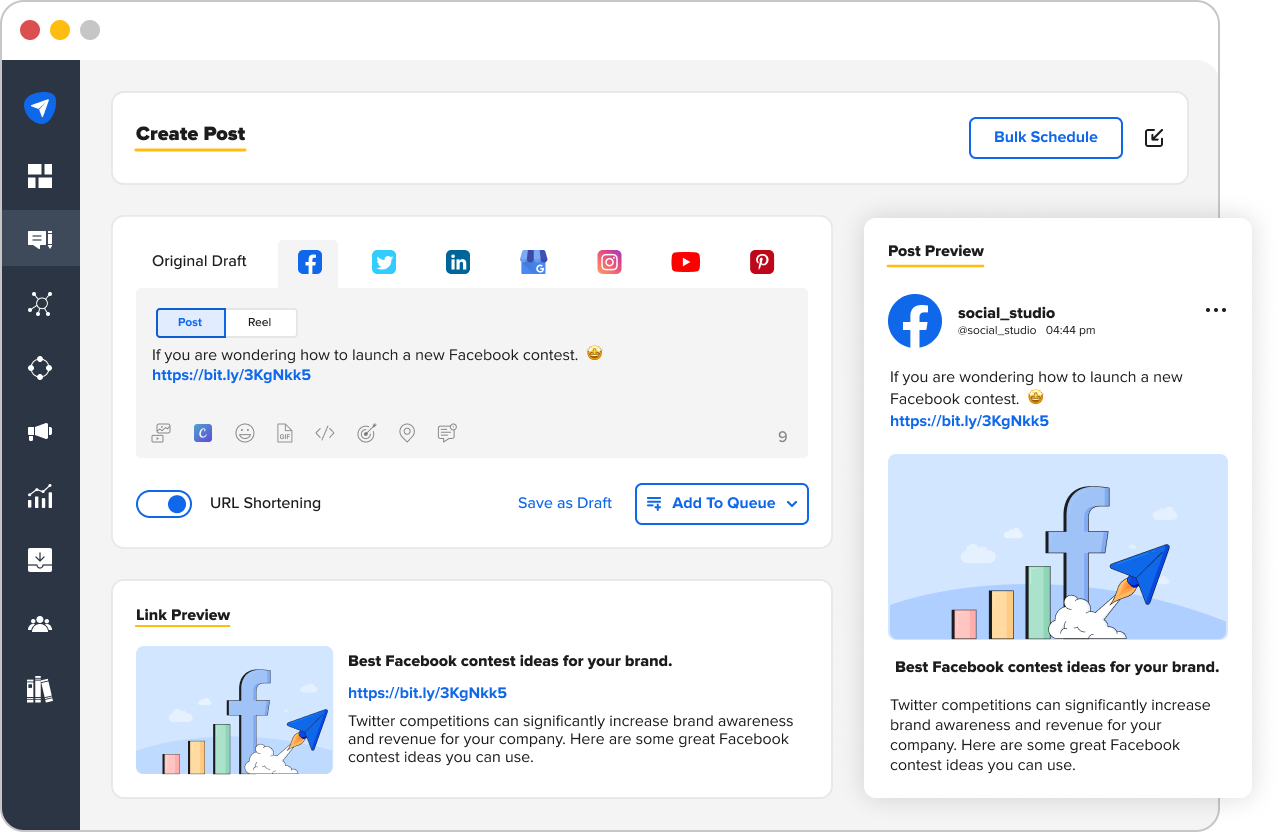
The tool includes a calendar feature that lets you see your social schedule for the week or month at a glance. And gives you the ability to reschedule posts quickly with the drag-and-drop interface.
Other features include a unified social inbox, approval workflows, and branded dashboards and reports.
There’s also the SocialPilot Chrome extension you can use to share content to your social media pages without switching tabs.
What We Like
SocialPilot integrates with Slack to send you instant notifications about issues you need to address, such as post errors or account disconnects. So you can address any problems quickly and ensure your social posts go live as planned.
Price
SocialPilot offers the following plans:
- Professional: $30 per month
- Small Team: $50 per month
- Agency: $100 per month
- Agency+: $200 per month
- Enterprise: custom pricing
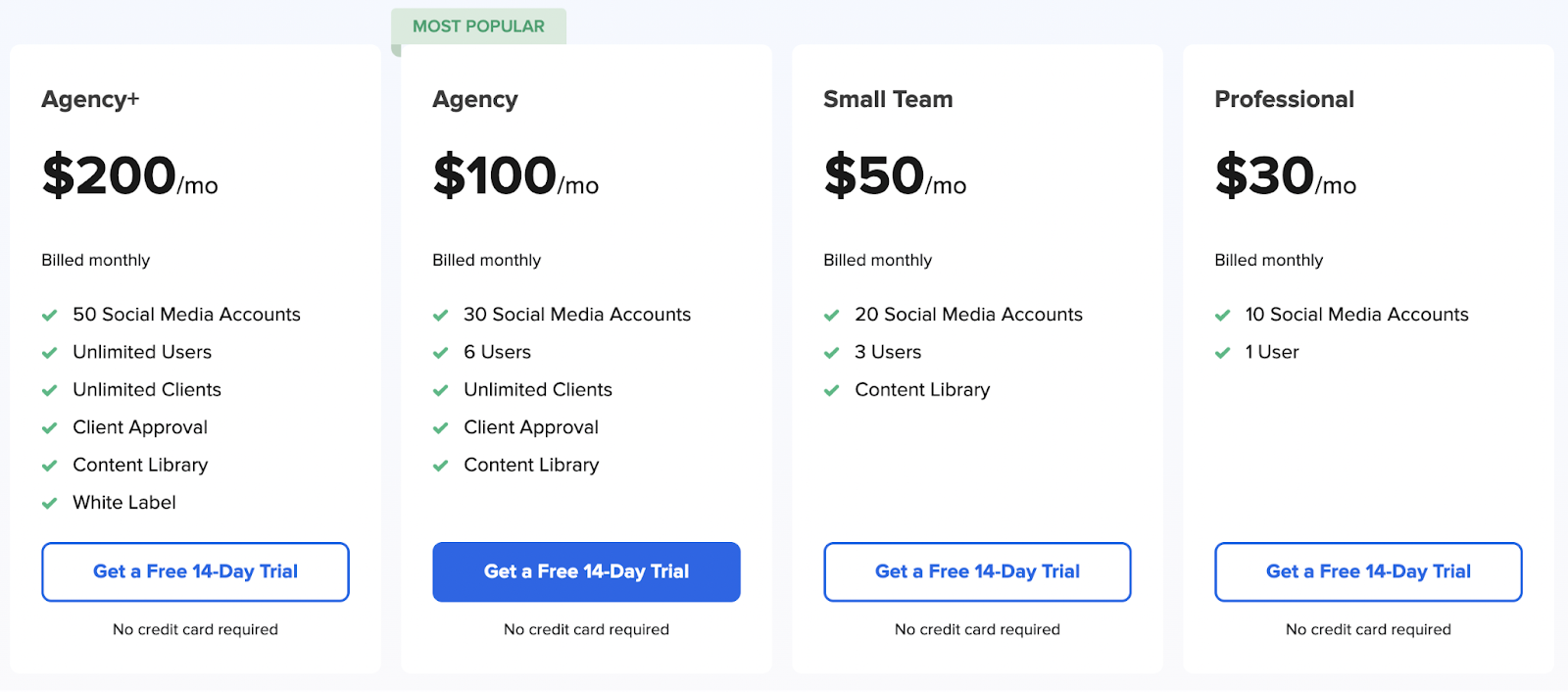
There’s also a free 14-day trial you can use to see whether SocialPilot is right for you.
12. Oktopost
Oktopost is a social media solution aimed at B2B teams.
It offers a social media calendar with drag-and-drop functionality and a unified inbox you can use to respond to comments and messages from a single location.
Oktopost’s AI social media content tool enables you to generate dozens of social posts quickly. And schedule them automatically across your social channels.
The software also includes employee advocacy features that help team members discover and share pre-approved content on their personal social media profiles. To amplify your brand’s reach.
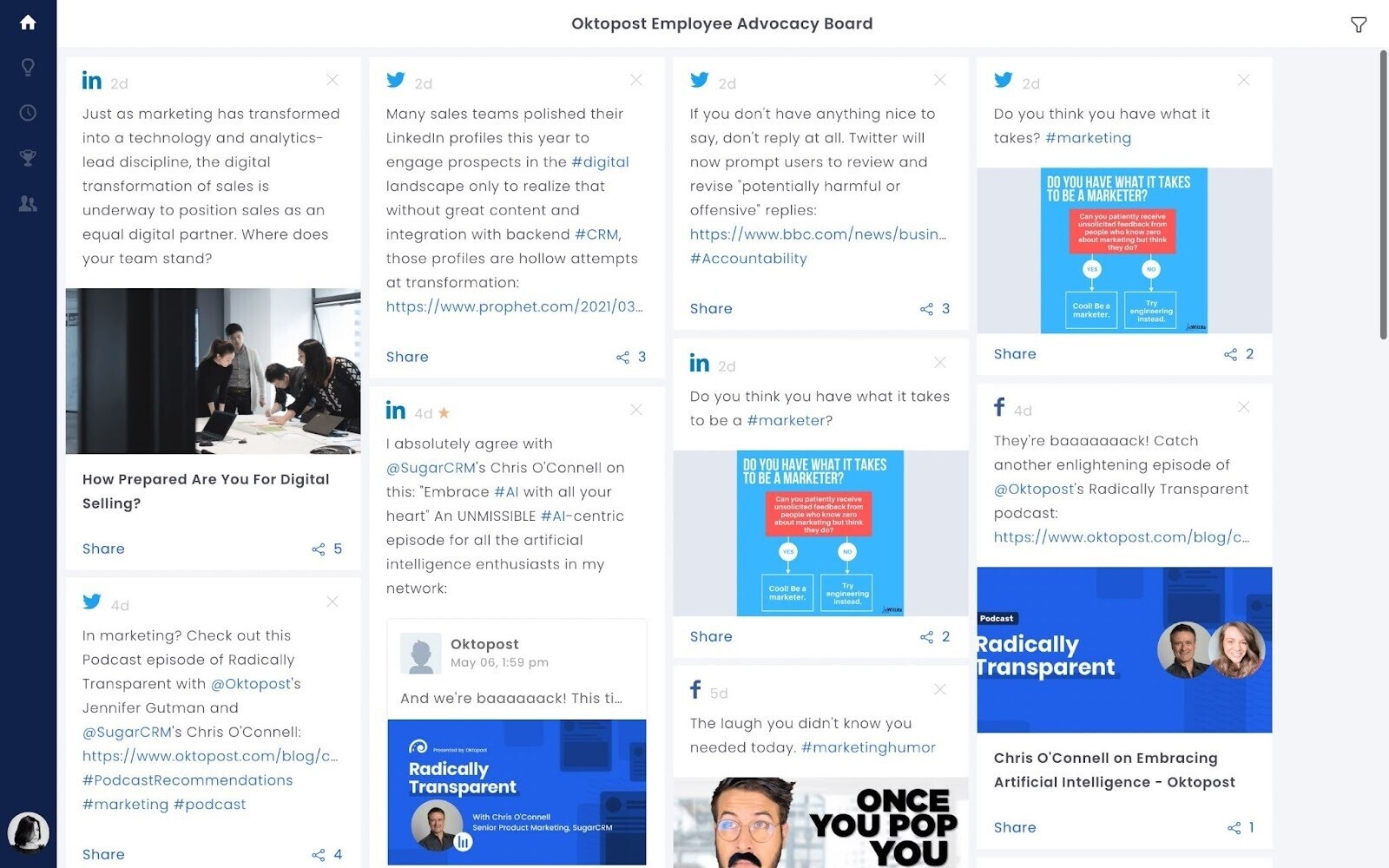
What We Like
Oktopost offers advanced reporting capabilities. You can use the software to build custom dashboards to analyze performance and determine your social media marketing return on investment (ROI).
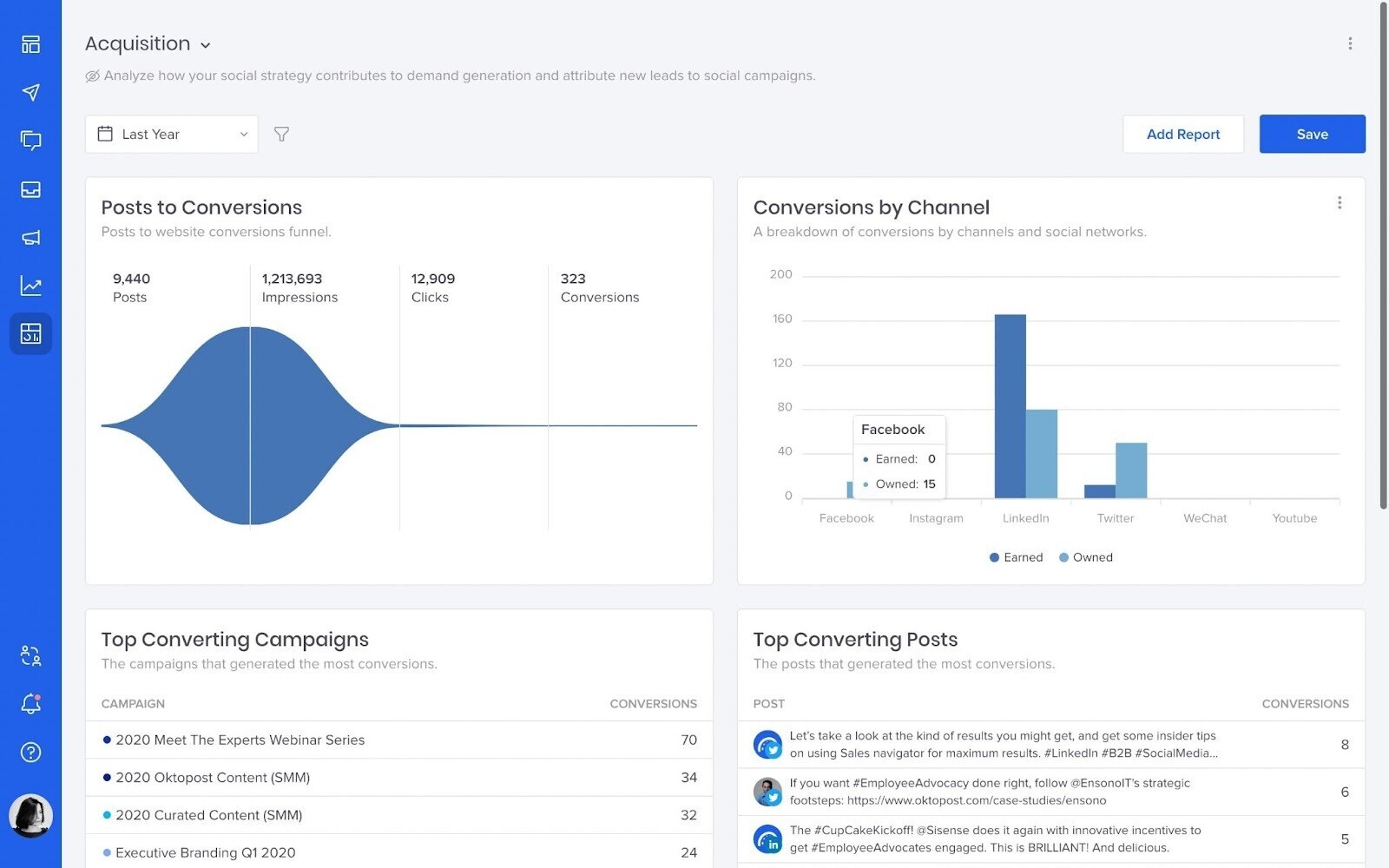
And you can schedule customized data exports that include the metrics most important to you (e.g., link clicks, conversions, brand mentions, or lead activities). To integrate the data with business intelligence (BI) tools like Microsoft Power BI or Looker for more advanced data analysis.
We also love the “Crisis mode” feature that allows you to quickly pause all social media activity. And automatically assign specific team members to take charge.
Price
Oktopost doesn’t share its pricing publicly. It’s customized for each customer and depends on the features and number of users needed.
13. Mention
Mention helps companies stay on top of brand sentiment and protect their reputation on social media.
You can use it to monitor Facebook, Instagram, and Twitter for mentions of your brand. And then respond accordingly.
You can even build your own alerts to make sure you don’t miss out on important conversations.
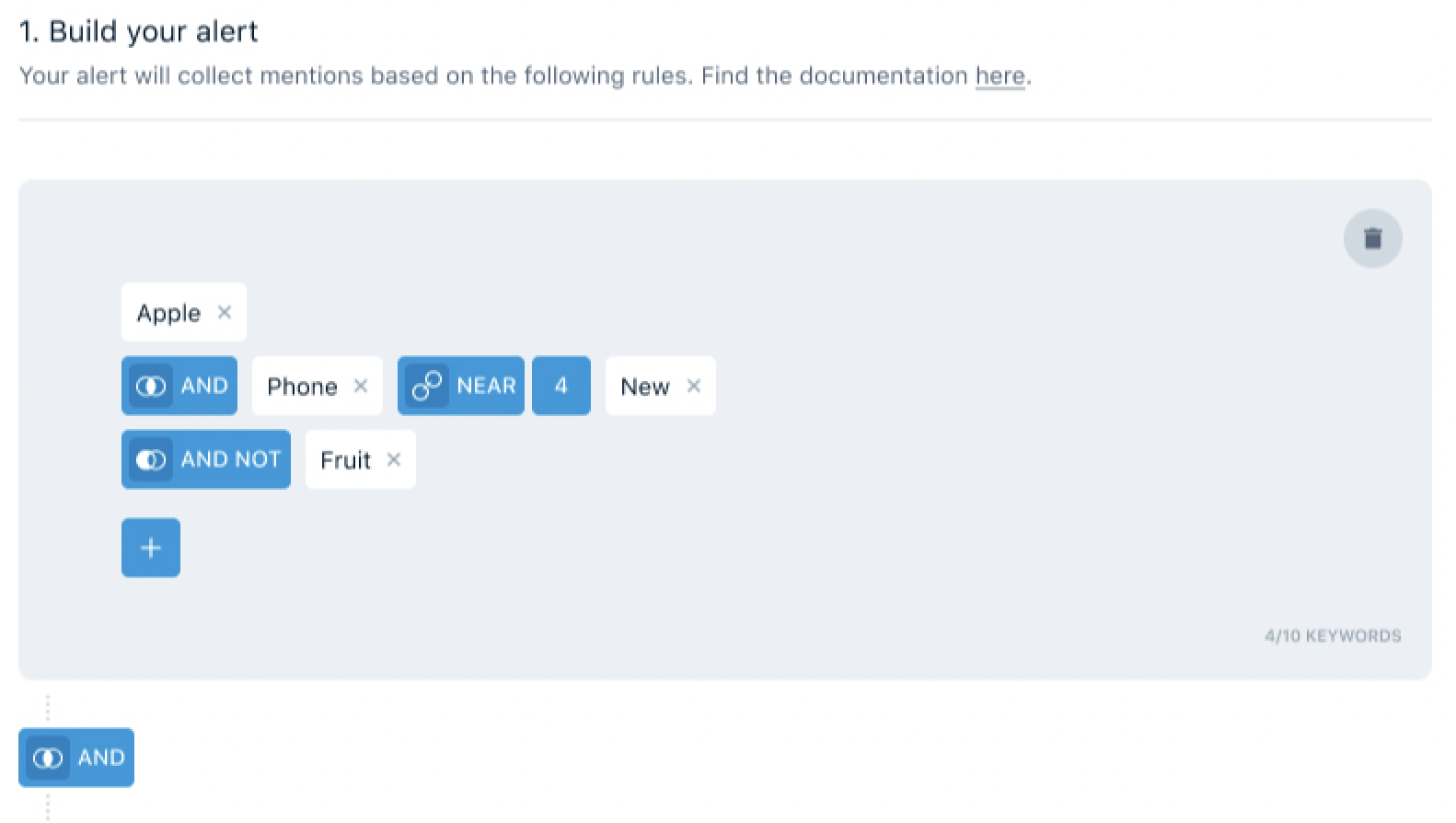
The software can also crawl other online sources (e.g., blogs, press articles, forums, and more) to find brand mentions.
And Mention offers publishing tools you can use to schedule and post content across multiple social media channels.
What We Like
The competitive analysis feature helps you keep an eye on your competitors and allows you to measure share of voice. So you can improve your social media strategy and stay on top of any big changes in your competitors’ strategies.
Price
Mention offers the following plans:
- Solo: $49 per month
- Pro: $99 per month
- ProPlus: $179 per month
- Company: custom pricing
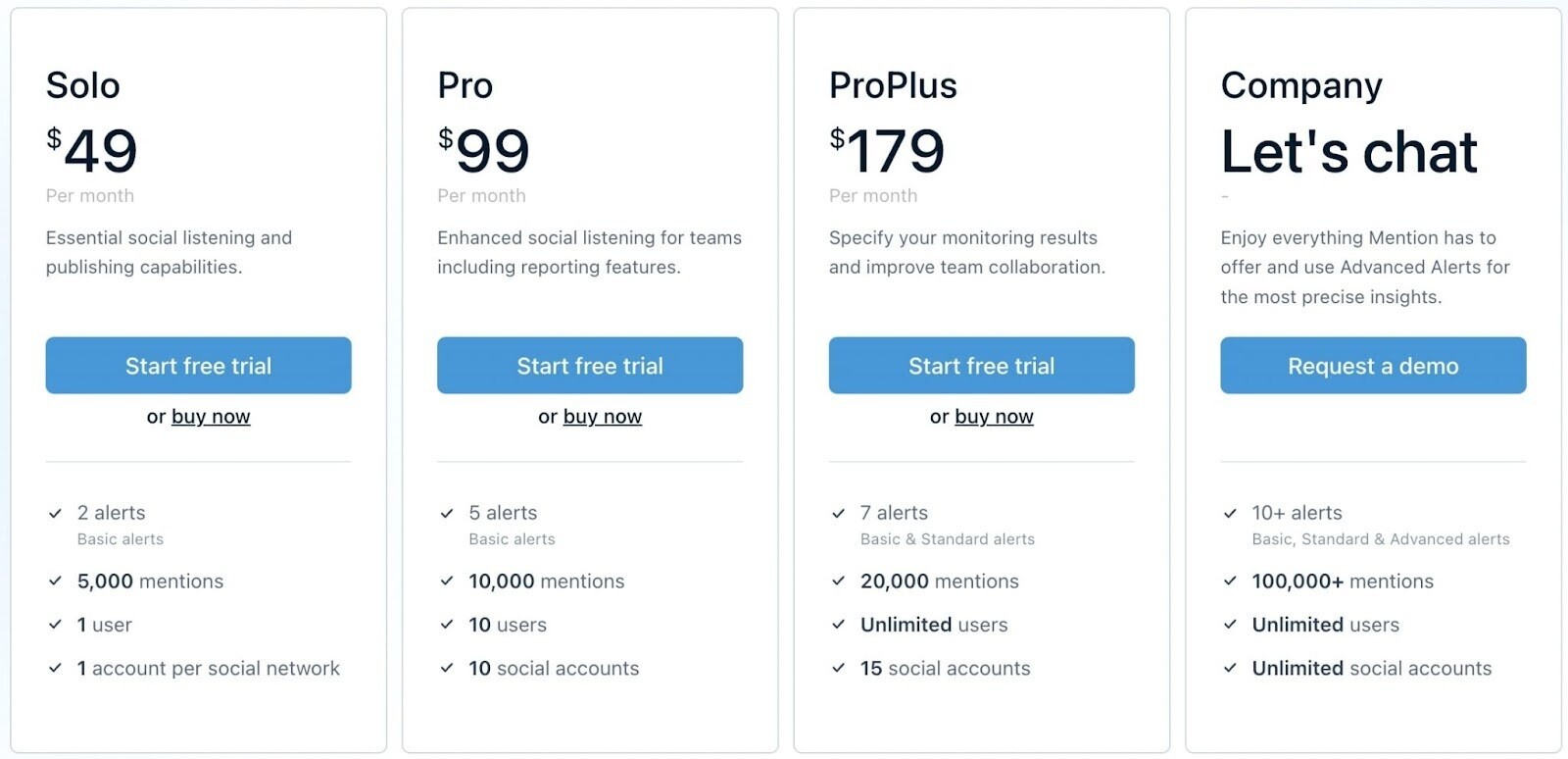
The Solo, Pro, and ProPlus plans each come with a free 14-day trial.
14. Brand24
Brand24 is a social media listening tool that tracks brand mentions across social media platforms, blogs, news websites, forums, and more.
It tracks more than 25 million online sources and uses sentiment analysis to identify positive, negative, and neutral mentions.
The software’s mentions feed feature allows you to see what people are saying about your brand and respond in real time.
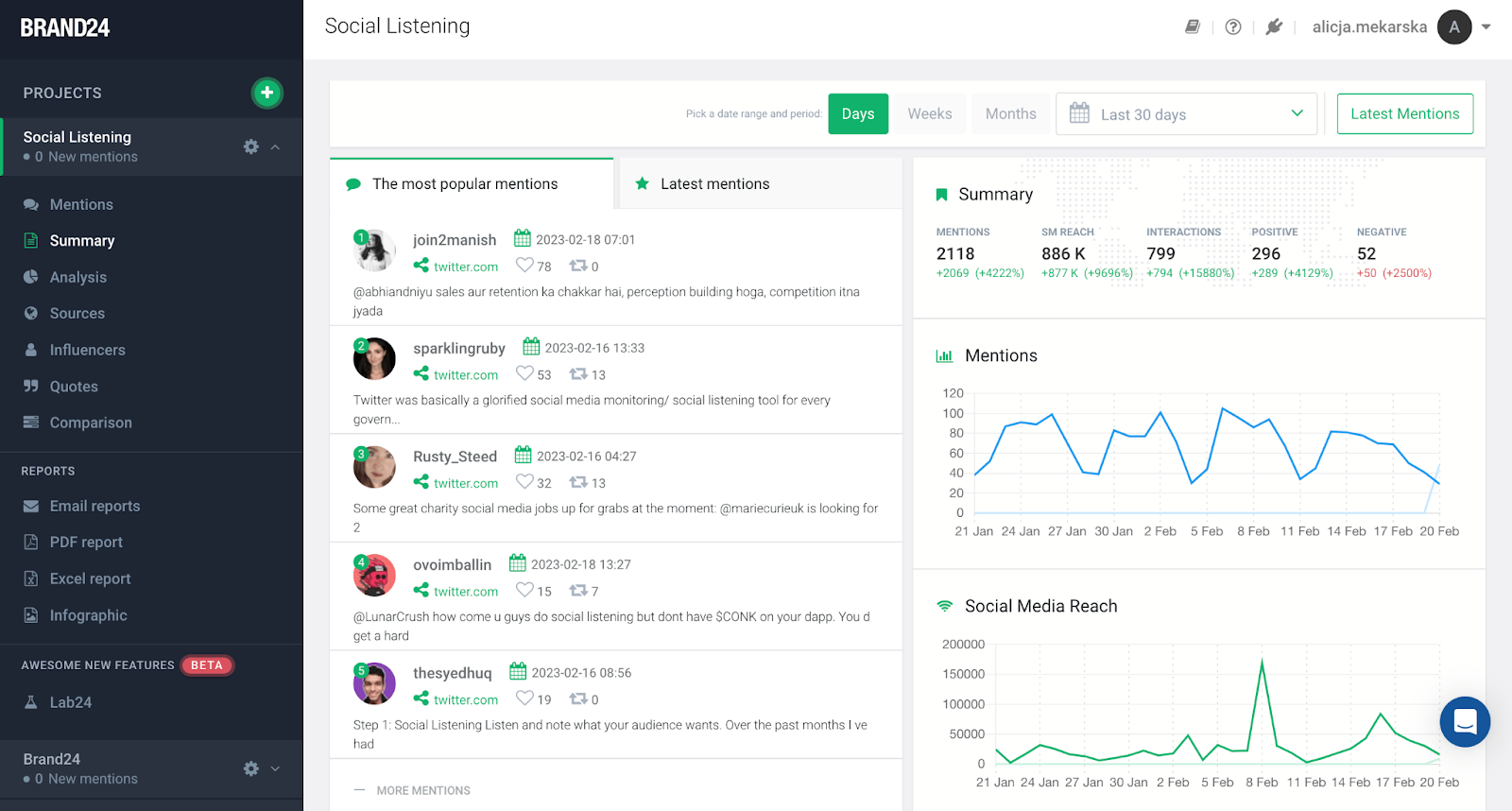
Brand24 also enables brands to generate detailed reports to evaluate brand awareness and benchmark results against their competition.
What We Like
Brand24 is able to track mentions across a wide variety of sources. Including a few that other mention tracking tools typically don’t focus on, such as TikTok and Telegram.
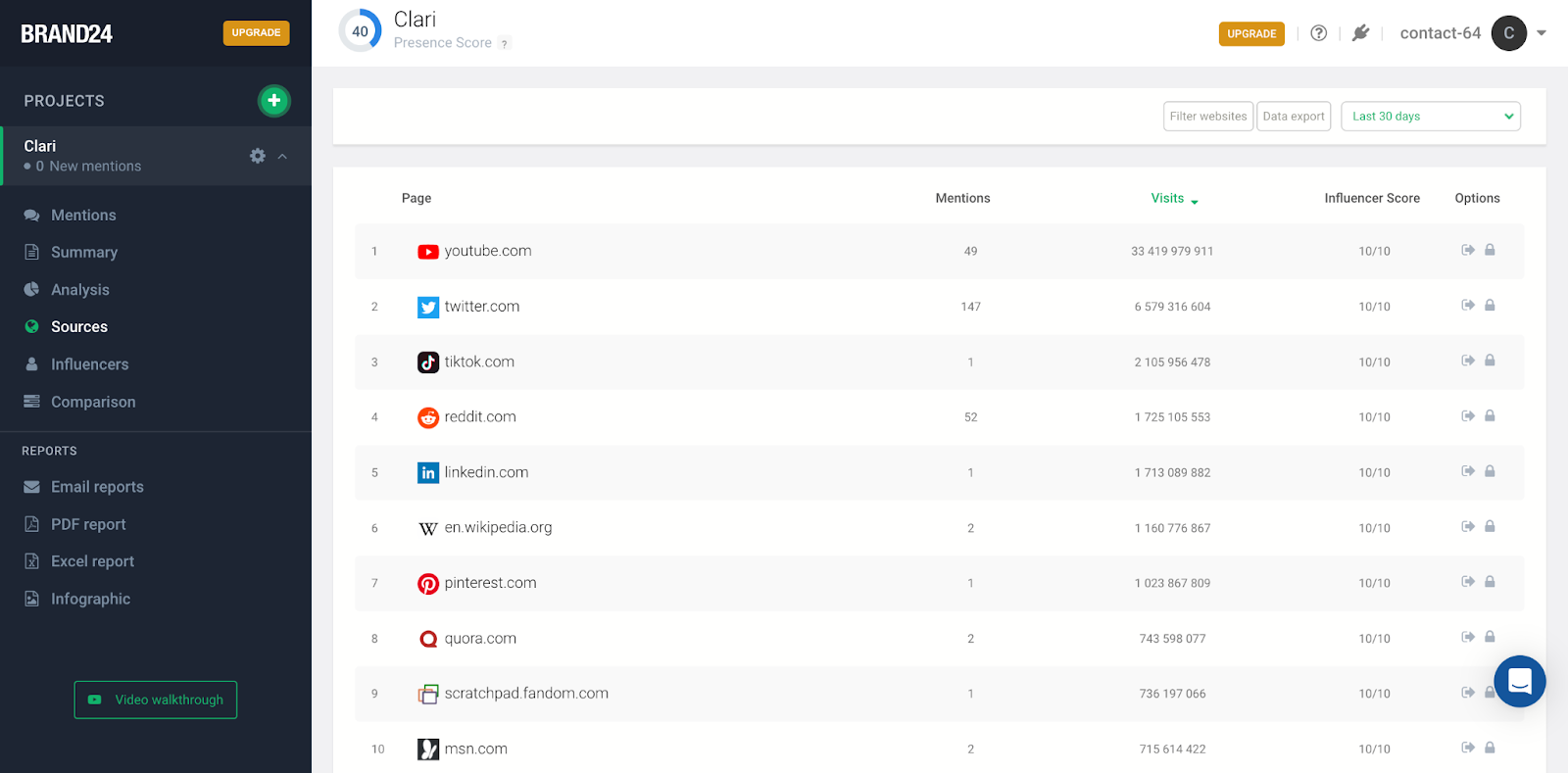
Price
Brand24 offers four plans:
- Individual: $79 per month
- Team: $149 per month
- Pro: $199 per month
- Enterprise: $399 per month
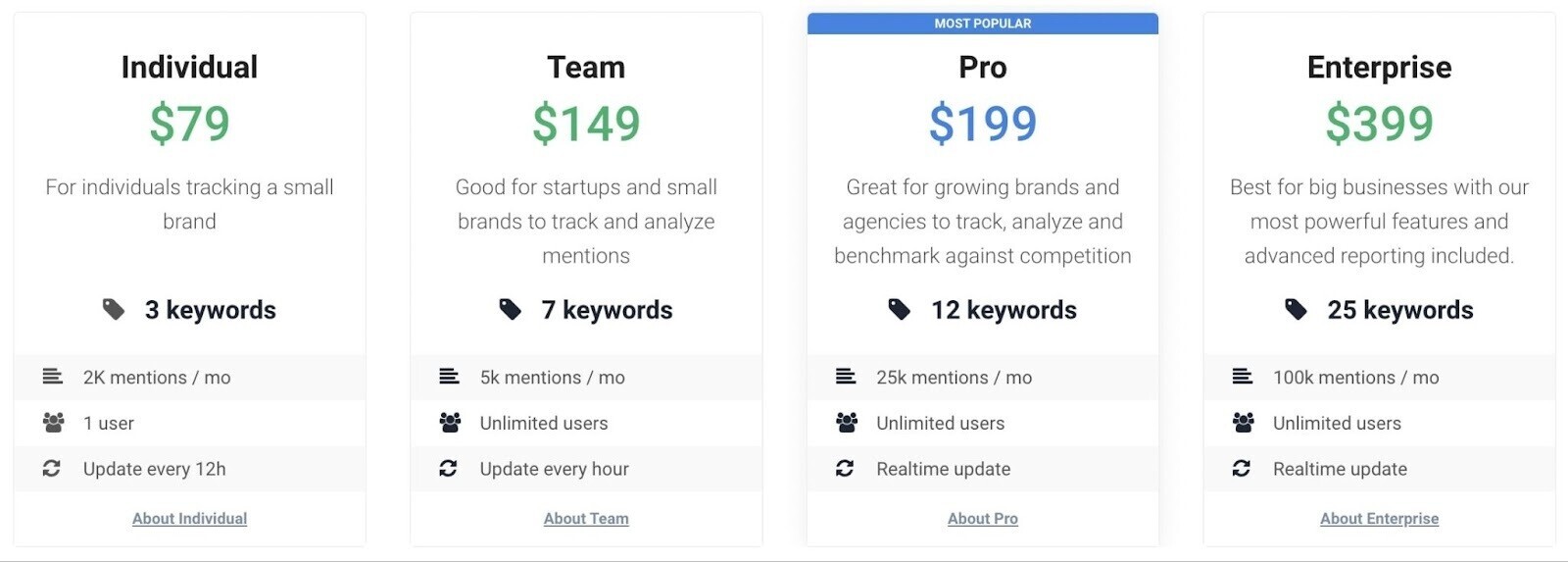
There’s also a free 14-day trial you can take advantage of to test out the software.
15. Statusbrew
Statusbrew is a social media marketing software that focuses on helping companies streamline social media management and automate tedious tasks such as comment moderation and spam filtering.
It offers a suite of tools for social media management across Facebook, Instagram, Twitter, LinkedIn, and Google Business Profile.
You can use it to schedule and publish posts across multiple social media networks with a single click. Or bulk schedule content by uploading a CSV file.
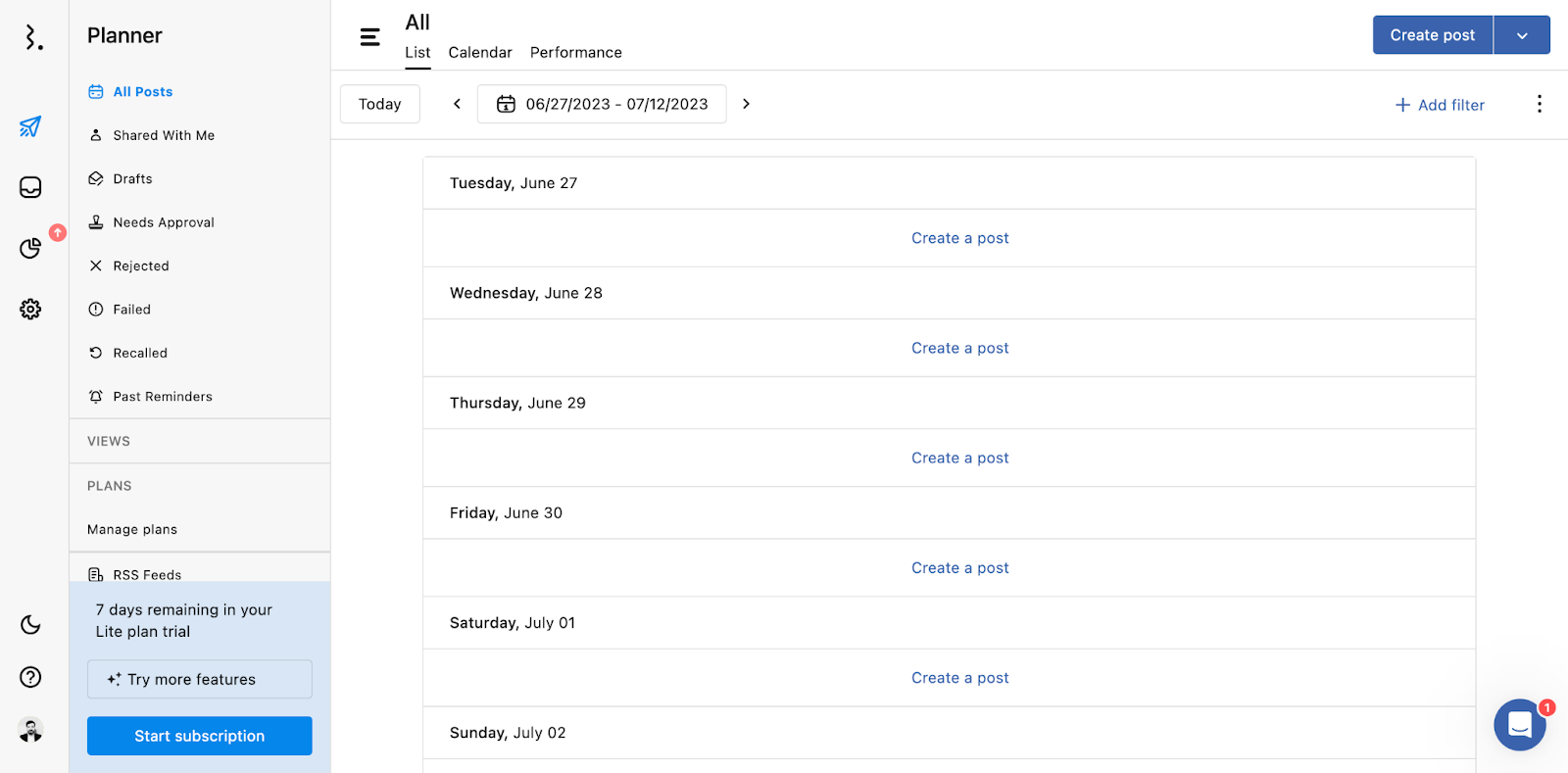
The unified inbox feature allows you to reply to messages you get across your social channels from a single location.
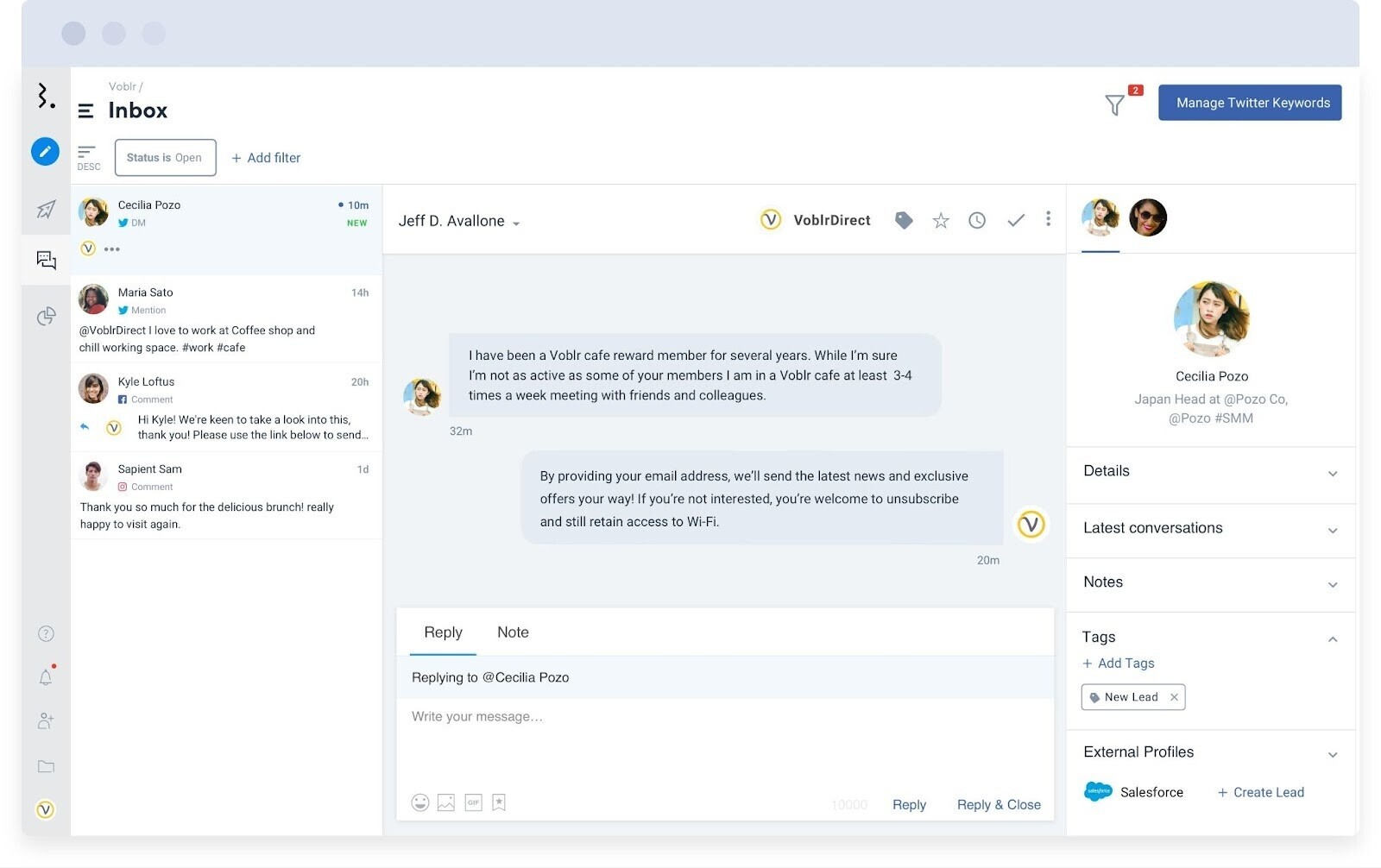
And the social listening feature helps you stay on top of brand mentions by tracking specific keywords and hashtags.
What We Like
Statusbrew has some great automation capabilities. First, there’s the feature that allows you to automatically hide comments on organic posts and ads based on a set list of words and phrases. And you can set up Statusbrew to automatically ban bots and users with suspicious activity.
There’s also the option to set up custom rules to automate your comment moderation workflow. Which saves time.
Price
Statusbrew’s plans include:
- Lite: $89 per month (billed monthly)
- Standard: $179 per month (billed monthly)
- Premium: $299 per month (billed monthly)
- Enterprise: custom pricing
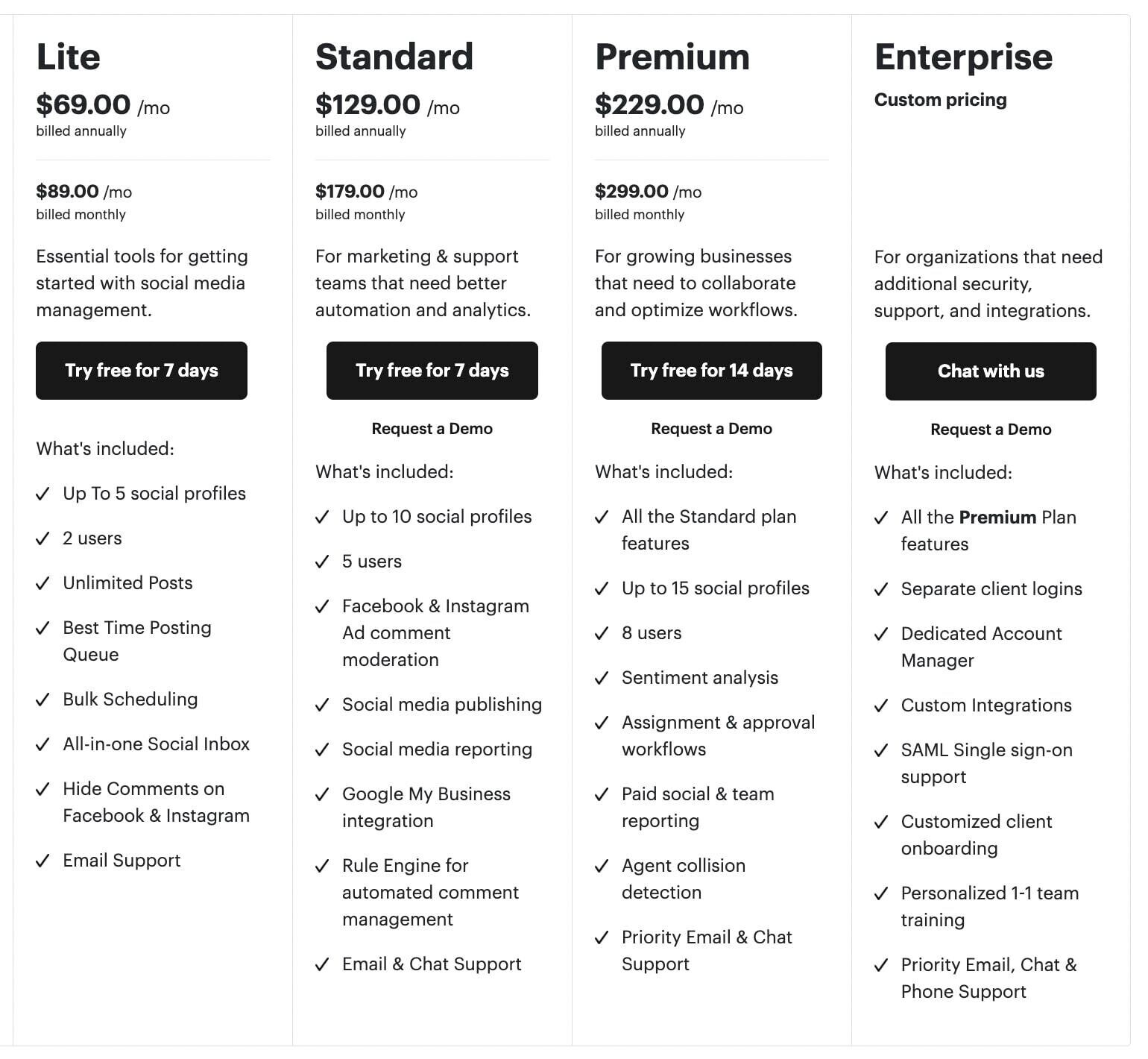
The Lite and Standard plans come with a free seven-day trial. There’s a free 14-day trial for the Premium plan.
16. Iconosquare
Iconosquare supports social media scheduling and publishing across Facebook, Instagram, Twitter, LinkedIn, and TikTok.
It includes an approval management workflow for stakeholders and clients to review, approve, or reject content.
There are also comprehensive analytics that help you track over 100 metrics to better understand your social media performance. Plus, you can create custom dashboards to review important metrics at a glance.
The software also has social listening features you can use to keep an eye on brand sentiment and track competitors’ performance.
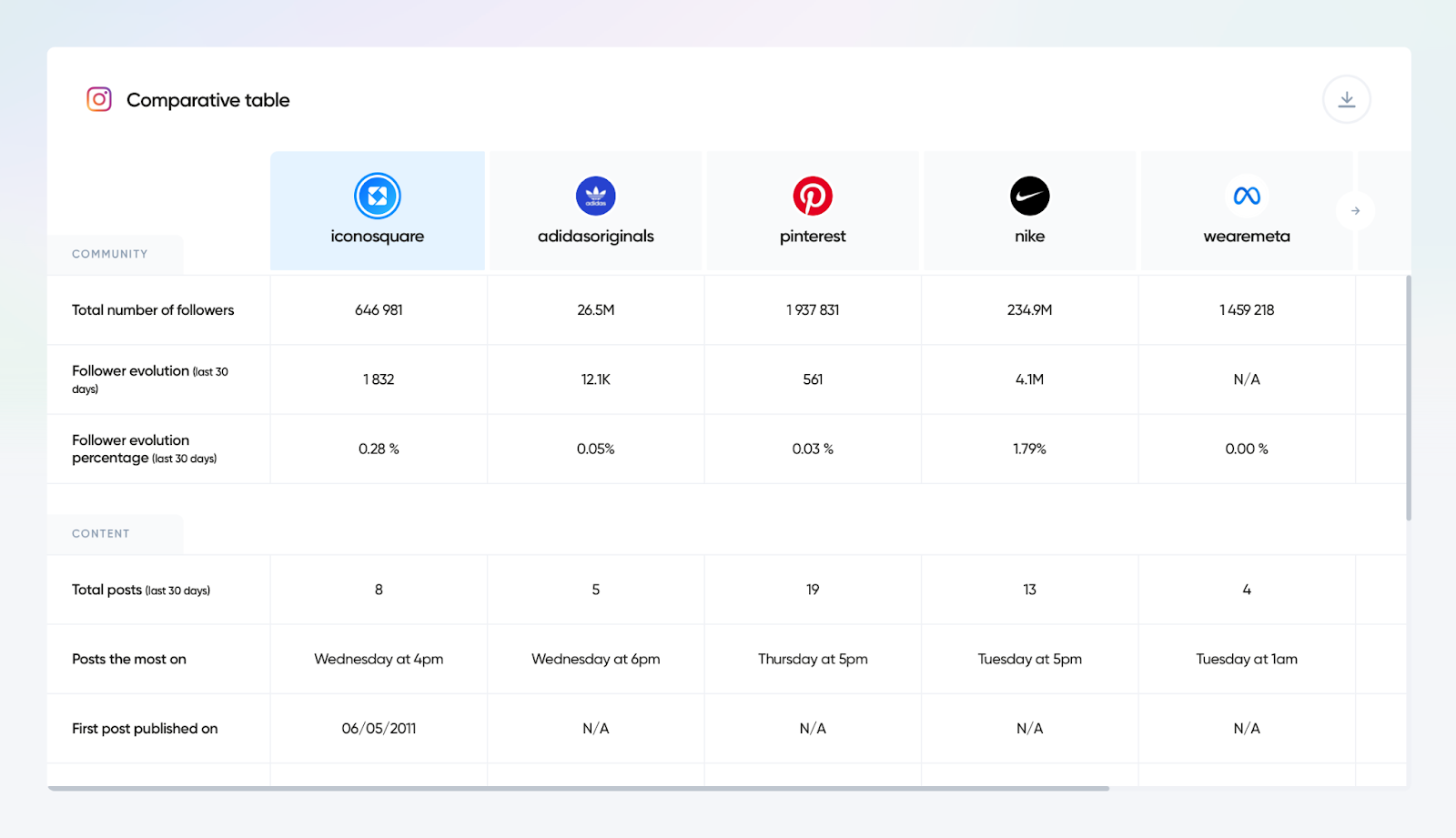
What We Like
Iconosquare’s comprehensive suite of analytics and reporting tools allow social media marketers to easily prove the results of their efforts.
The tool tracks over 100 different metrics and supports custom reporting dashboards. Plus, it enables marketers to visualize community growth, demographic trends, and content performance through automatically generated graphs. Which can be exported and shared with stakeholders in a couple of clicks.
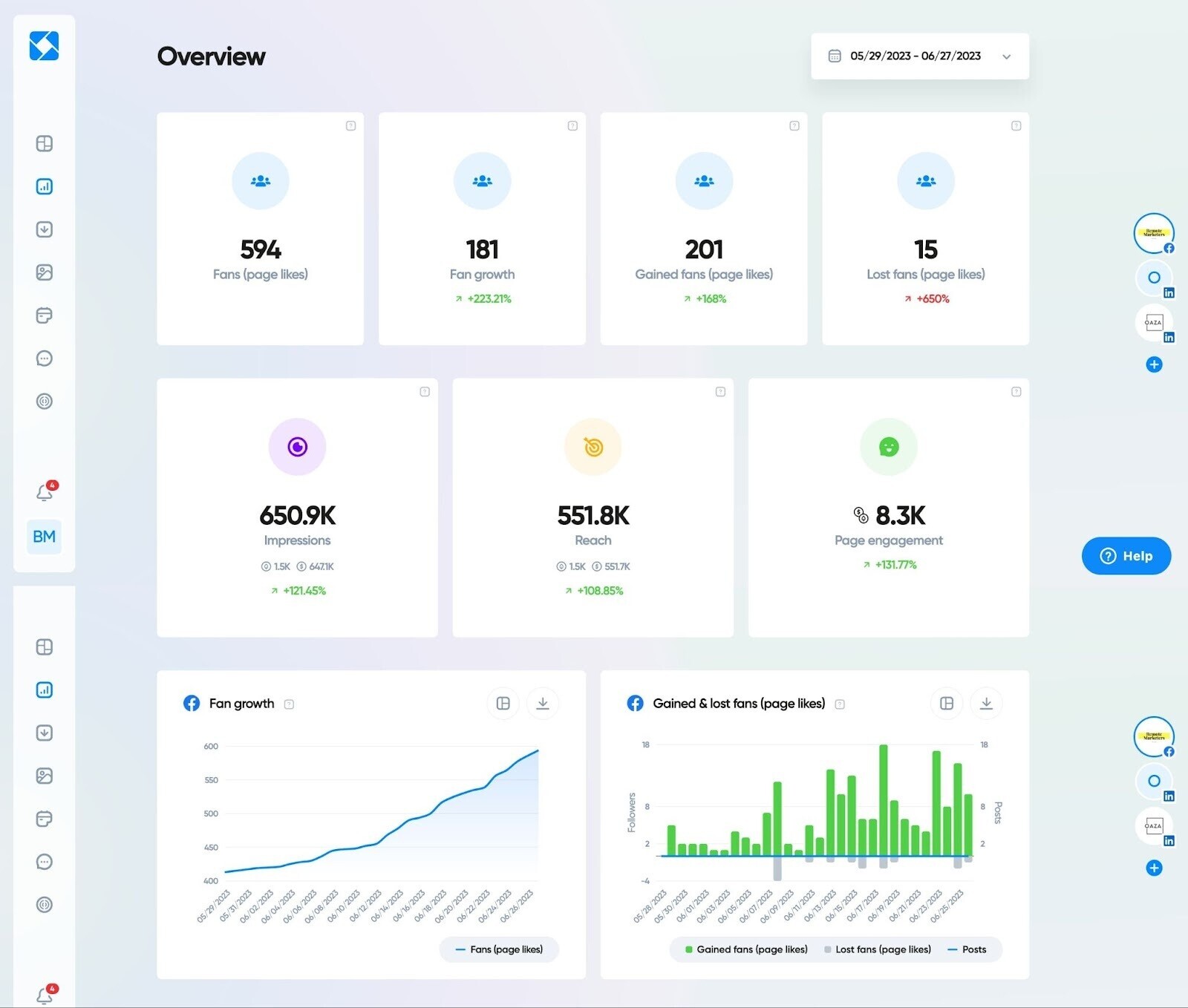
Price
Iconosquare has three pricing plans:
- Pro: 59€ per month (about $64 per month)
- Advanced: 99€ per month (about $108 per month)
- Enterprise: 179€ per month (about $195 per month)
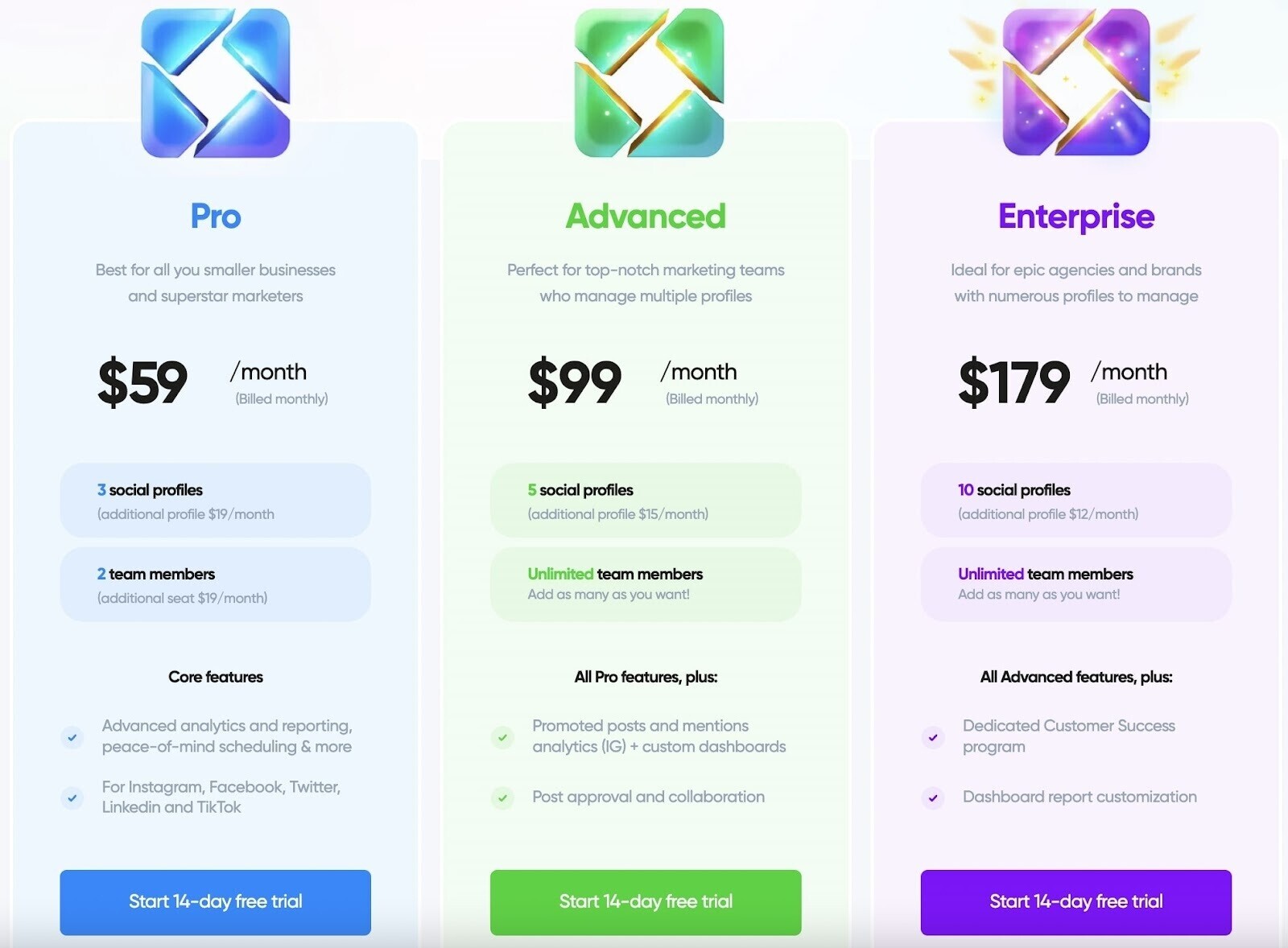
There’s also a free 14-day trial for all plans.
17. HeyOrca
HeyOrca offers social media planning, scheduling, collaboration, approval, and reporting features for teams and agencies.
The software supports Twitter, Facebook, Instagram, LinkedIn, Pinterest, and Google Business Profile.
HeyOrca has a visual post editor that shows how published posts will appear. And a social media calendar with drag-and-drop functionality.
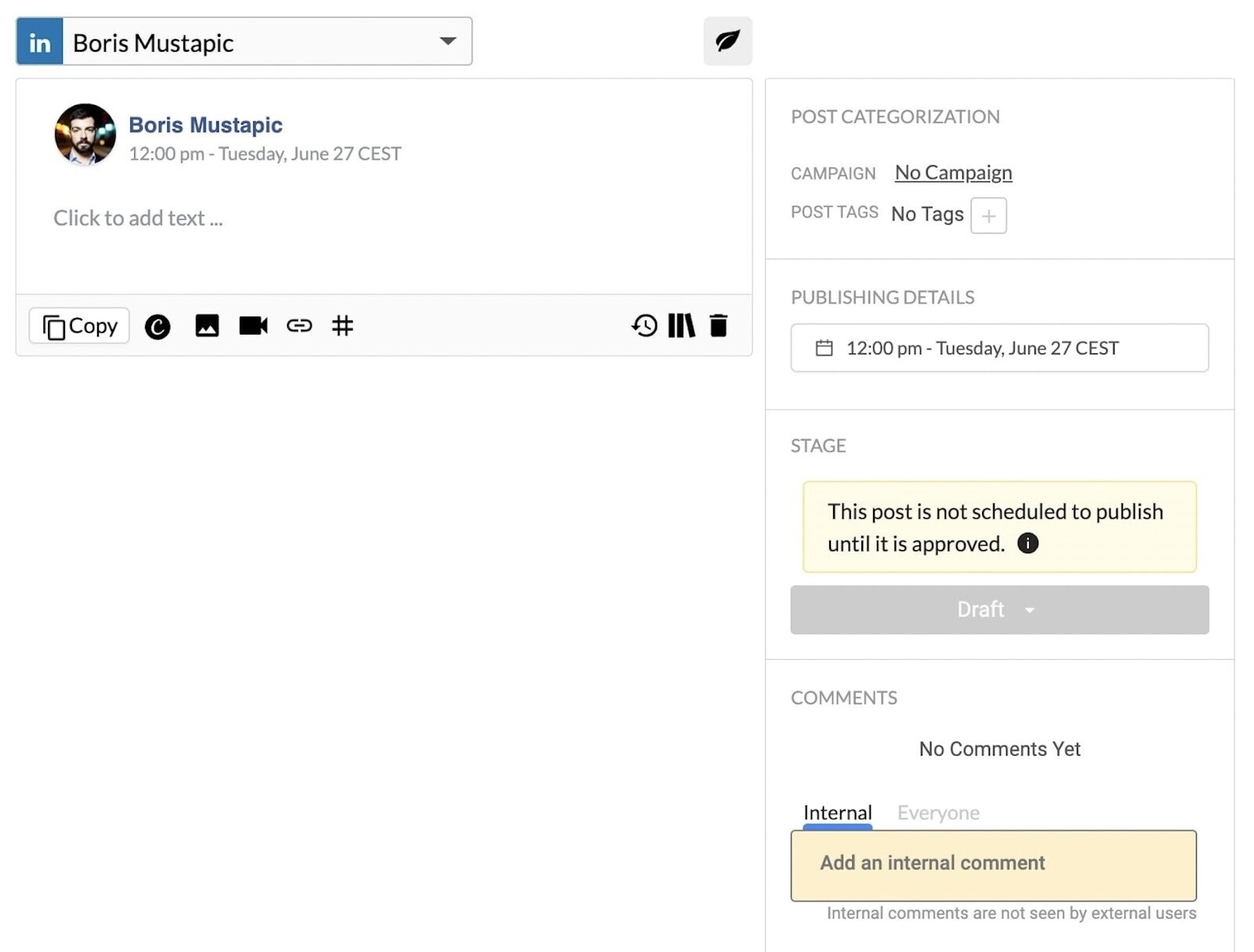
Approval features let you share posts with clients and stakeholders to get feedback quickly. And clients are able to request revisions with a single click.
What We Like
The automated approval reminders are useful for getting clients and internal stakeholders to take a look at post drafts sooner rather than later.
Price
HeyOrca’s pricing depends on the number of social media calendars you need. For a single calendar, pricing is as follows:
- Basic: $59 per month
- Standard: $99 per month
- Pro: $149 per month
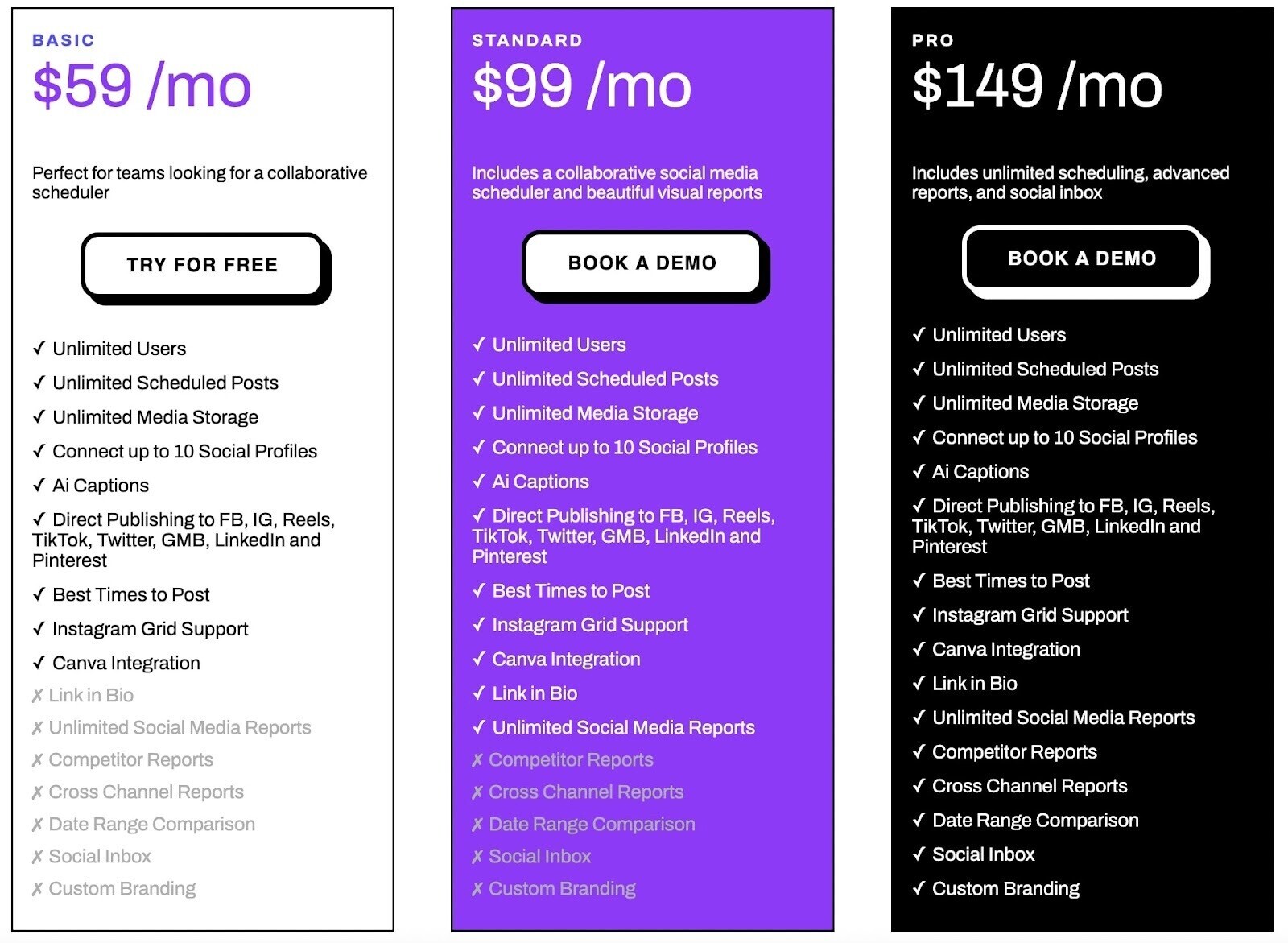
18. Swat.io
Swat.io is a social media management software suite for B2B teams. It includes three core products: Publisher, Inbox, and Suite.
The Publisher tool includes social media planning and scheduling features. And supports publishing content to Twitter, LinkedIn, Facebook, Instagram, YouTube, TikTok, and Pinterest.
With the Inbox tool, you can review and reply to messages and comments received across your social media channels. And assign tasks to specific team members.
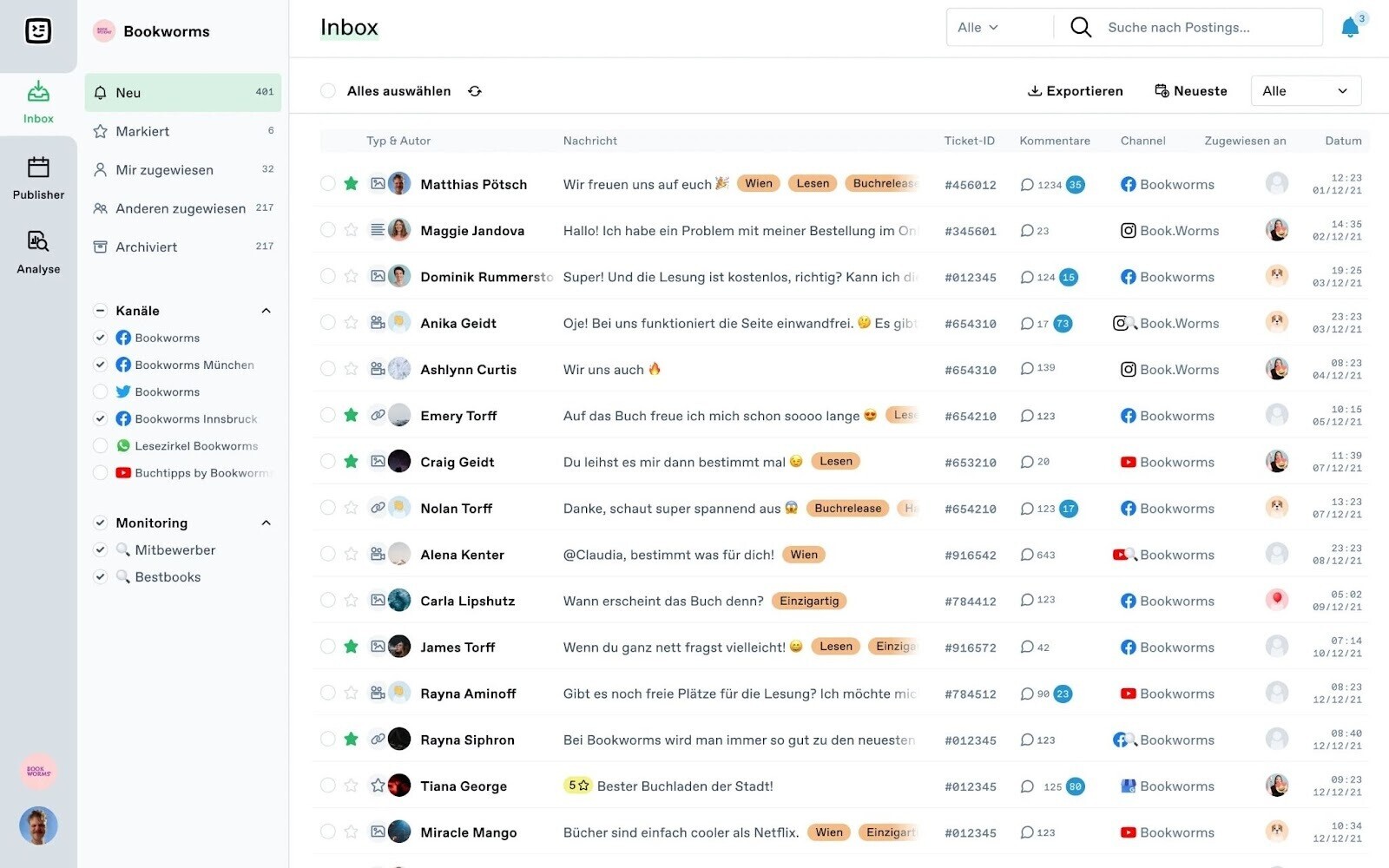
Suite includes both the Publisher and Inbox tools. Plus comprehensive analytics and reporting features.
What We Like
Swat.io’s AI social media assistant can help you brainstorm post ideas, generate captions, and even suggest images to use within your social posts.
Price
Swat.io’s pricing depends on the number of social media channels and users you need. The pricing for one channel and one user is as follows:
Publisher
- Basic: 35€ per month (about $38 per month)
- Pro: 70€ per month (about $76 per month)
- Enterprise: custom pricing
Inbox
- Basic: 35€ per month (about $38 per month)
- Pro: 70€ per month (about $76 per month)
- Enterprise: custom pricing
Suite
- Basic: 56€ per month (about $61 per month)
- Pro: 112€ per month (about $122 per month)
- Enterprise: custom pricing
All Basic and Pro plans include a free 21-day trial.
Leverage Tools to Optimize Your Social Media Presence
A good social media tool is crucial for streamlining your social media marketing efforts and staying on top of monitoring your brand reputation.
Get started with Semrush Social. It has everything you need to schedule posts, respond to messages, review analytics, and more.
